[Research] Freelance Translator Survey 2023
See how you compare to colleagues when it comes to rates, CPD, and business practices
Published on 8 December 2023, Last updated 11 December 2023
These findings are based on a worldwide survey of freelance translators carried out by Inbox Translation in collaboration with the Institute of Translation and Interpreting (ITI) in February and March 2023.
The purpose of the survey is to better understand the translation profession and the people working within it. Since this is a follow-up to our previous survey of freelance translators, conducted in 2020, we are also able to compare the findings over time.
The survey sample
A total of 2,803 freelance translators took part in the 2023 survey and answered at least some of the questions, almost double the number (1,510) who participated in 2020. Numbers completing each specific question are shown in the results.
Their length of experience as a translator ranged from less than a year to more than 30 years (Figure 1).

Of the 1,729 respondents that provided information on their gender, 76% reported that they are female, 23% male and 1% non-binary/other, a very similar gender distribution to the 2020 survey sample. (Figure 2).
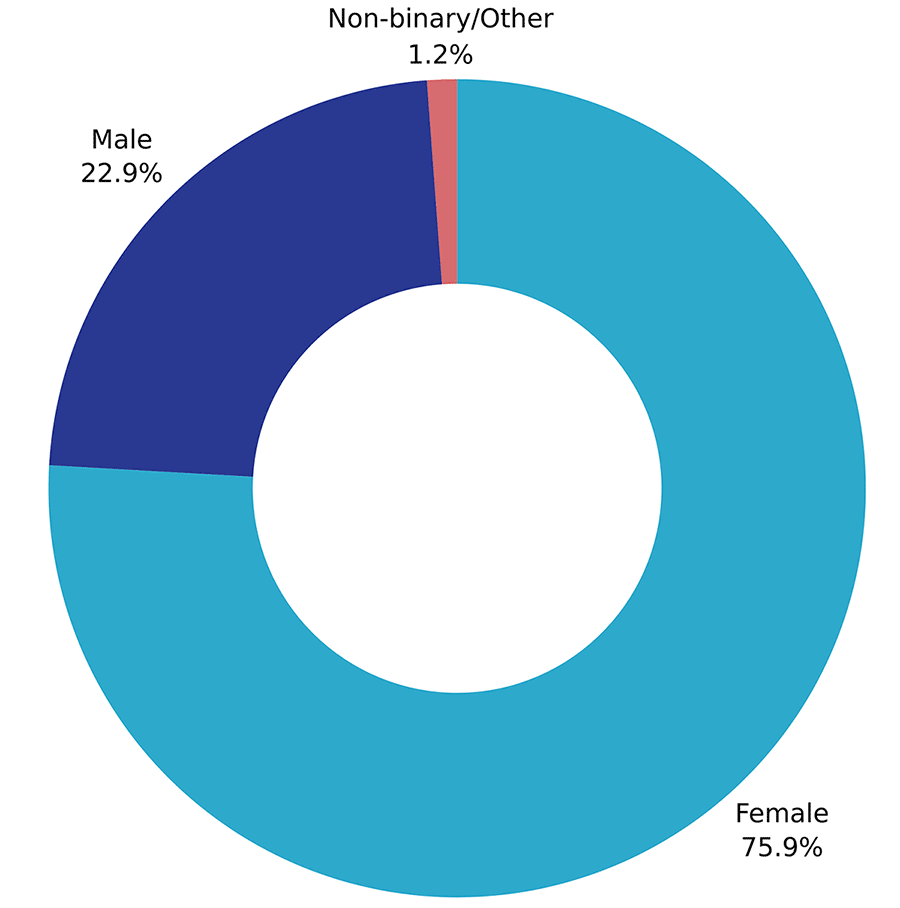
A wide range of ages were again represented in the survey, from under 25 to over 65 (Figure 3).
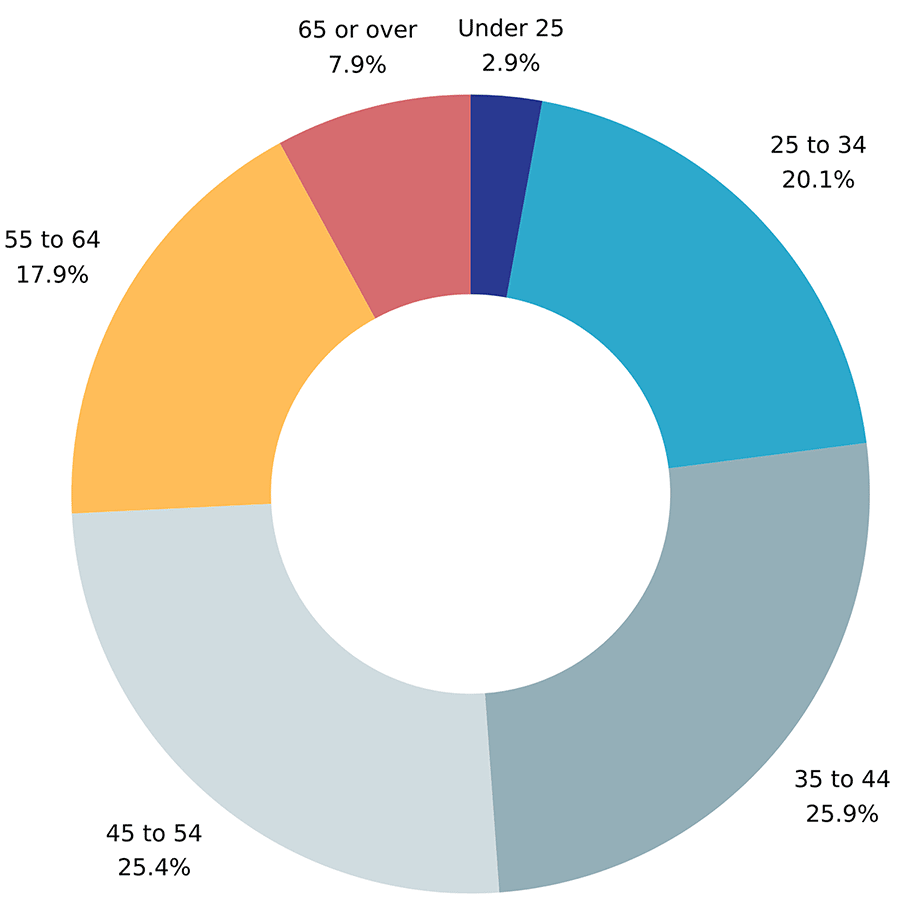
When asked to indicate which country they are currently based in, a total of 107 countries of residence covering all continents were mentioned by the 1,725 respondents who provided this information. The geographical coverage of the 2023 survey has therefore expanded from the 94 countries of residence reported by the 2020 survey participants.
Around a third (34%) of respondents to the 2023 survey reported that they are based in the United Kingdom, compared with 19% in 2020. In 2023, the UK-based respondents were followed in frequency by those based in France (9%), Spain (7%), Italy (7%), Germany (4%) and the USA (3%). Figure 4 shows the distribution of survey respondents by geographic region in 2023. Seventy-eight percent (1,347) reported that they are based in Europe, covering a total of 46 different countries within this continent.
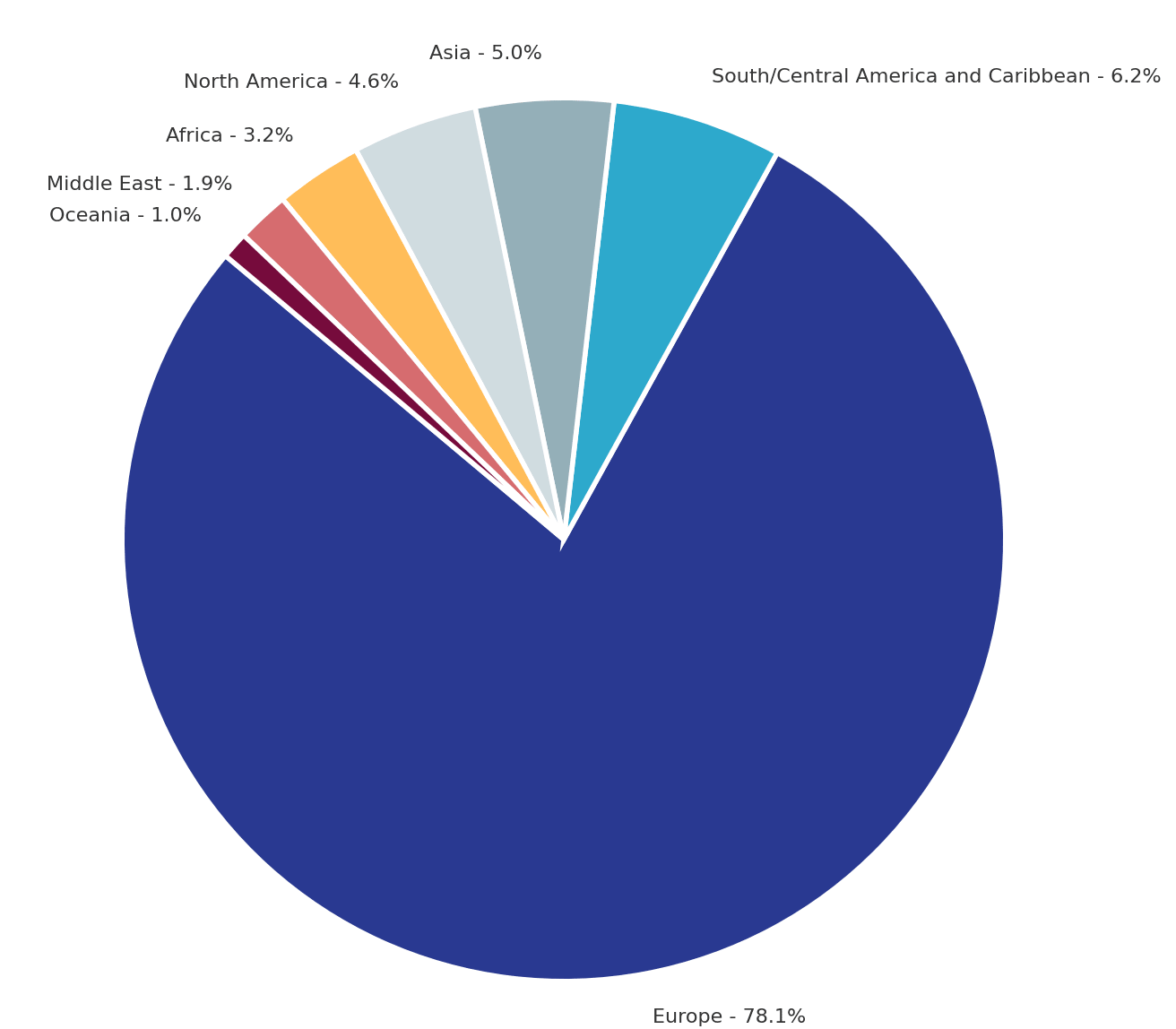
We were also interested in finding out about the educational backgrounds of freelance translators, and asked respondents to indicate which of a list of higher educational qualifications they hold (they could tick more than one). Figure 5 shows the percentage of respondents with each type of qualification.
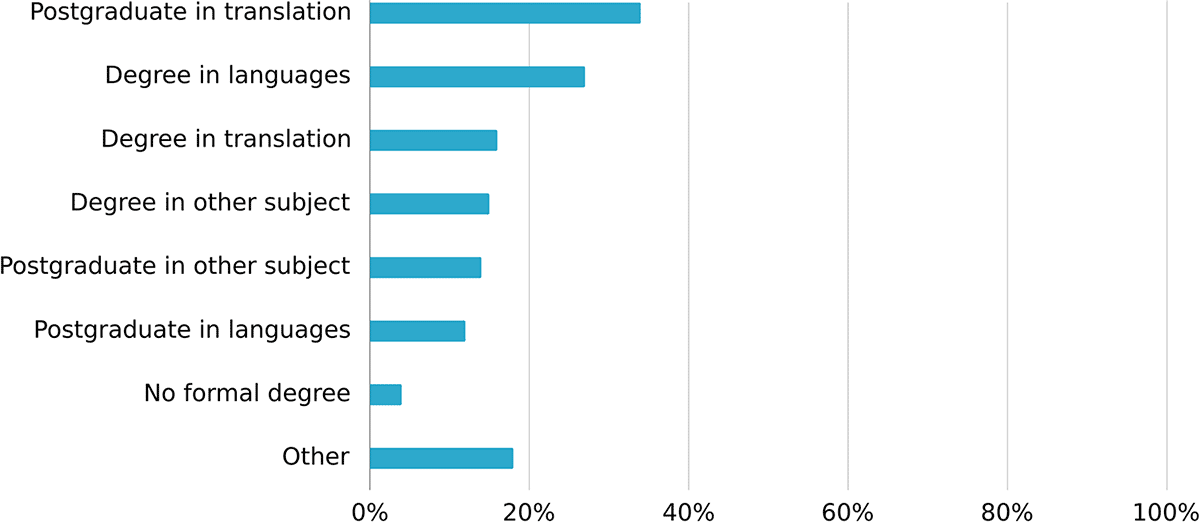
Figure 5 shows that around a third of survey respondents in 2023 hold a master’s degree or PhD (ISCED Levels 7 and 8) in translation or similar, with this being the most commonly mentioned qualification. In addition, 12% of the sample indicated that they hold a master’s degree/PhD (ISCED Levels 7 and 8) in languages, and 14% hold a master’s degree/PhD (ISCED Levels 7 and 8) in a different subject.
Since respondents were able to tick more than one qualification, it is not possible to determine the total number holding a postgraduate qualification, but clearly this is a highly educated and qualified sample of translators. The findings contrast slightly with the 2020 survey sample, in which a bachelor’s degree in languages or a bachelor’s degree in translation (ISCED Level 6) were the most commonly mentioned qualifications.
In 2023, only 4% (n=104) of the sample indicated that they have no qualifications at bachelor’s degree or above, while 18% (n=468) said that they have another professionally relevant qualification.
Analysis of the “other – please specify” responses given by those respondents who cited “other” qualifications indicated that many of these actually fell within the listed qualifications category, as they consisted of a degree or postgraduate qualification. Some mentioned specialist qualifications in other fields such as law.
Other commonly cited qualifications were a diploma in translation (Chartered Institute of Linguists (CIOL) or another awards body), and a certificate (in translation or another subject), a master’s/postgraduate/advanced diploma, and MITI.
41% of women and 31% of men have a postgraduate degree in translation
We wanted to see whether there were marked differences when it comes to the routes into the profession taken by men and women. There are two areas where this was noted: 22% of men vs 13% of women have a degree in another subject, while 41% of women vs 31% of men have a postgraduate qualification in translation. (Figure 6)
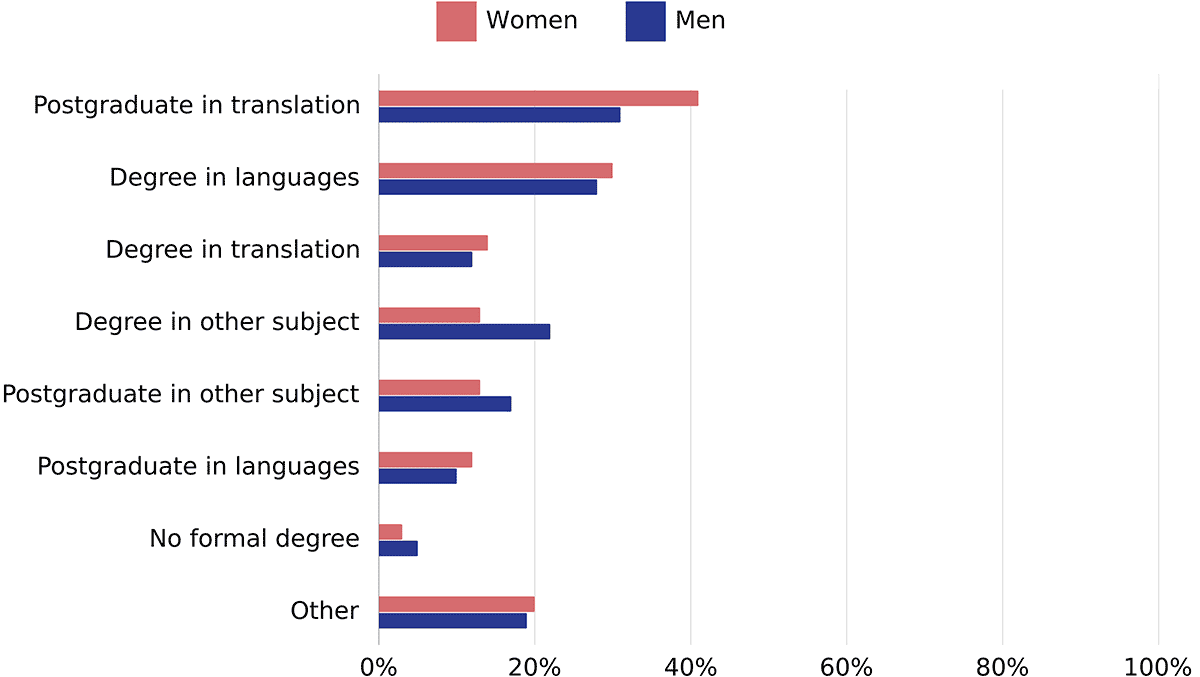
65% of respondents work exclusively as freelance translators
Of the 2,803 freelance translators who took part in the survey, 65% indicated that they work only as a freelance translator, 17% combine translation with other freelance language-related services such as editing or copywriting, and the remaining16% work as both a translator and an interpreter. (Figure 7). Those who do not provide any translation services (2%) did not qualify to continue with the survey.
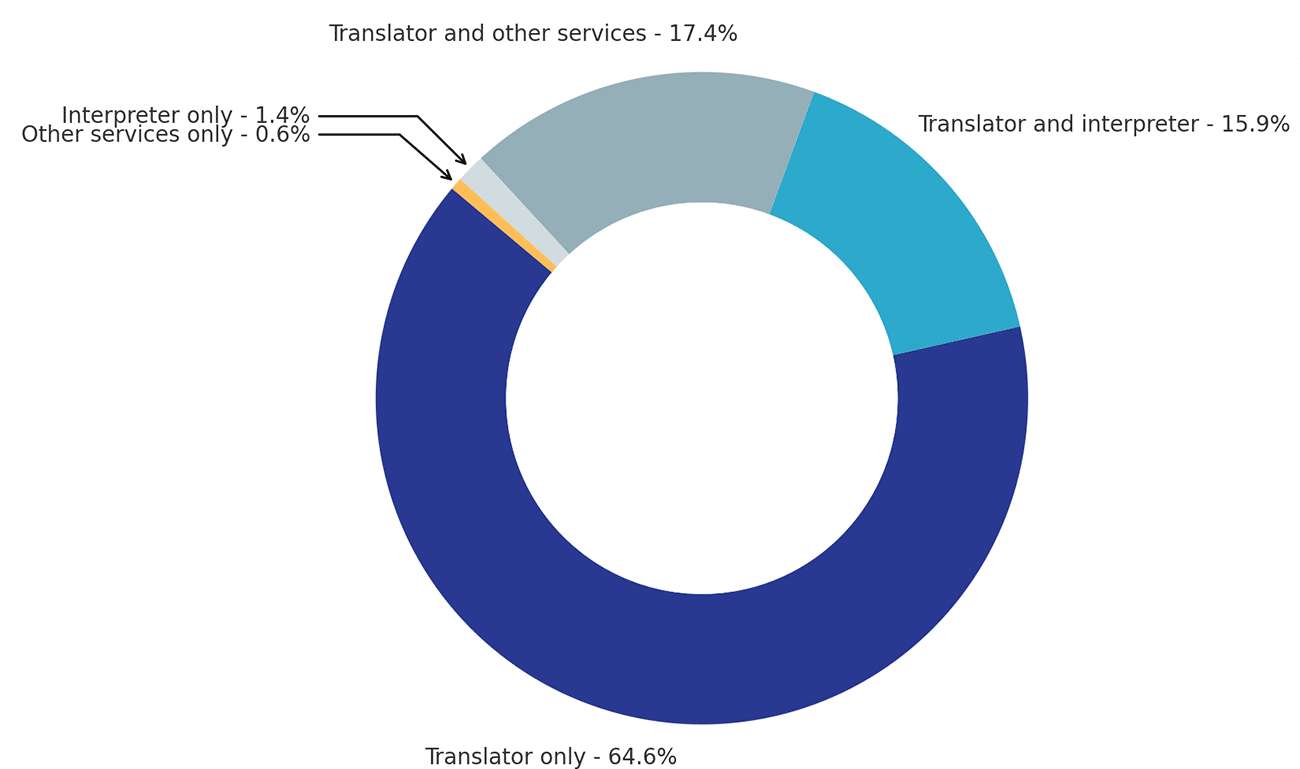
The main reason for providing other services in addition to translation is because they choose to (68%)
Those respondents who said they provide other services in addition to translation were asked to indicate which of a number of listed reasons explain why they do so (they were allowed to tick more than one).
905 respondents answered this question and the percentages indicating that each of these reasons applies to them are shown in Figure 8.
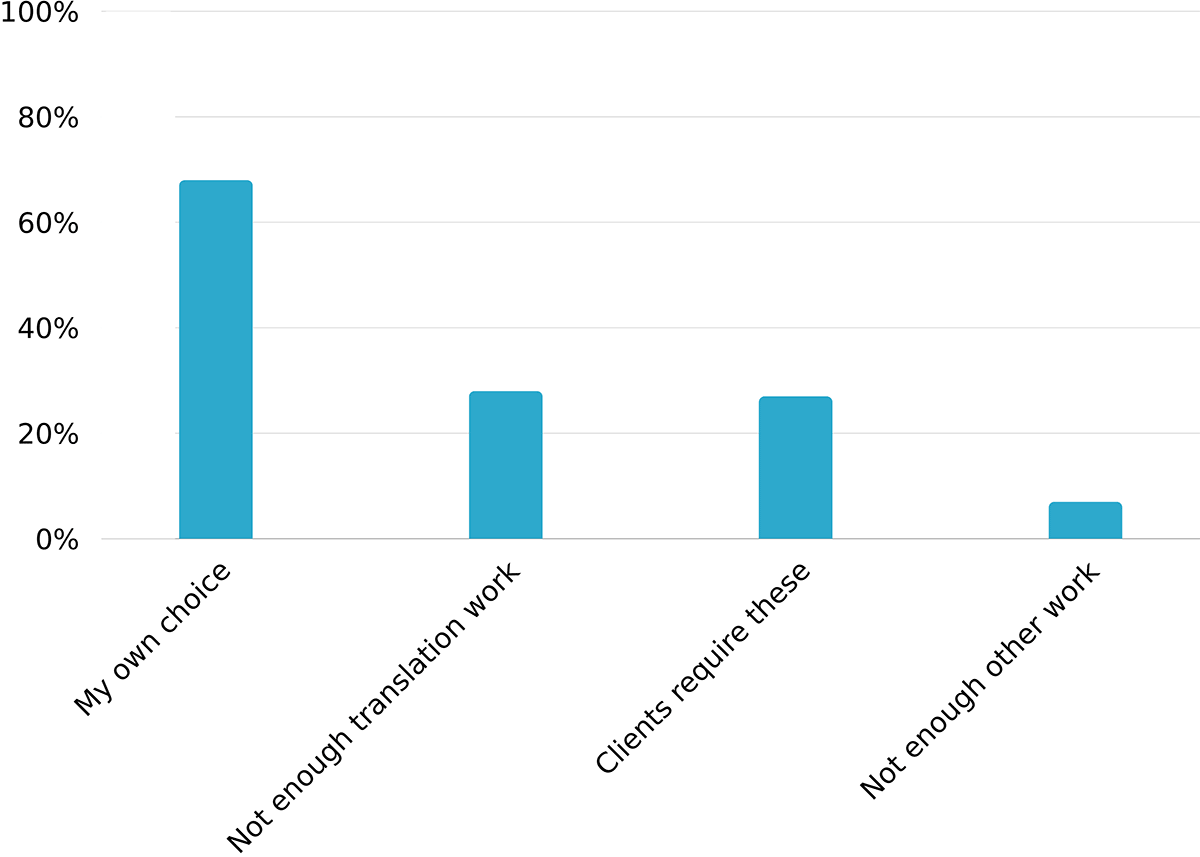
The distribution of responses relating to reasons for providing more than one type of service was broadly similar to the corresponding findings in 2020. The first two statements reflect positive reasons for combining freelance translation with other services, with the majority (68%) indicating that they choose to provide multiple services and just over a quarter (27%) doing so because their clients require these.
However, 28% reported that they provide more than one service because they can’t secure enough translation work, while 7% said they offer translation services as they are unable to secure enough work as a provider of other services alone.
We also asked respondents who provide multiple services to indicate whether they would prefer to work exclusively as a translator, exclusively as an interpreter or exclusively as a provider of other services.
As in 2020, relatively few ticked these responses, as shown in Figure 9, suggesting that most respondents who provide freelance translation alongside other services are happy to do so. However, 15% of those offering multiple services said they would prefer to work only as a freelance translator.
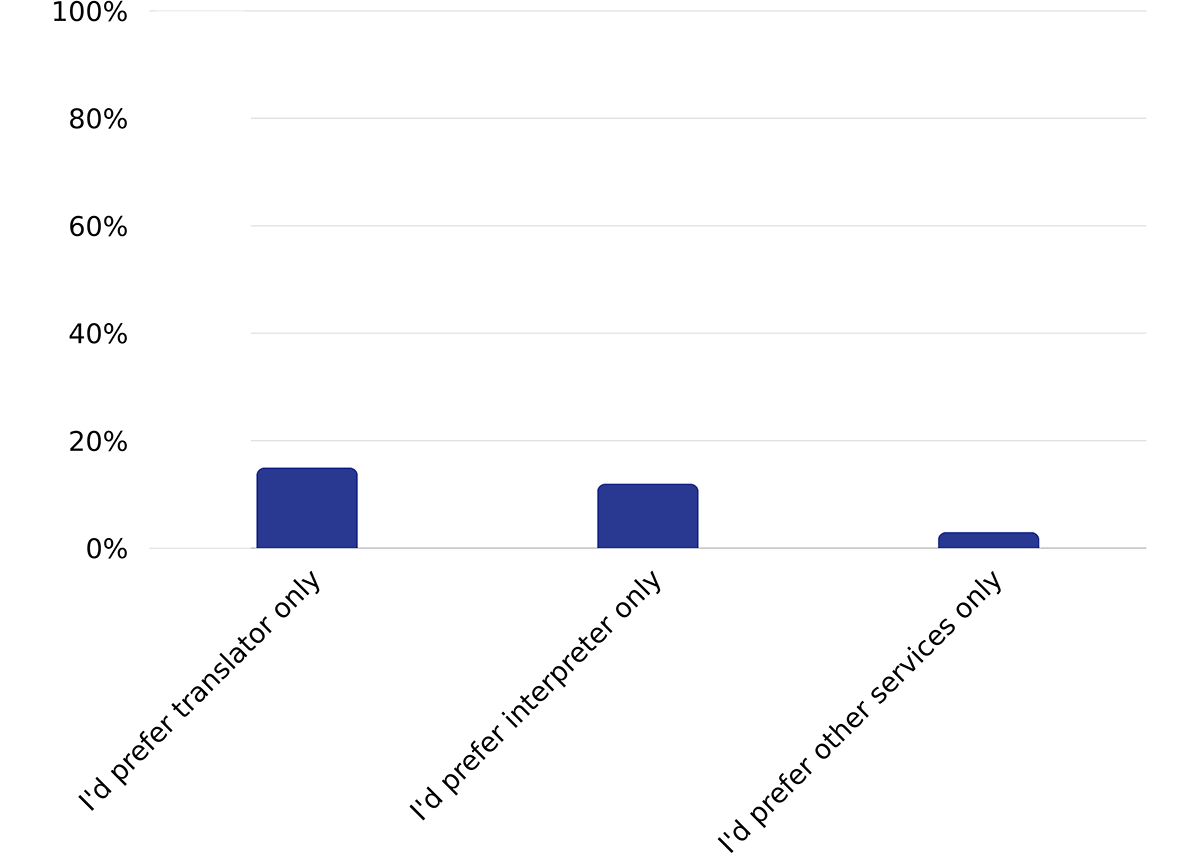
Language combinations
There were 328 different language combinations reported in the survey. The number of respondents for the most common languages mentioned are listed below.
| From |
|---|
| English (n=1,075) |
| French (n=394) |
| German (n=294) |
| Spanish (n=220) |
| Italian (n=119) |
| Into |
|---|
| English (n=1,199) |
| Italian (n=219) |
| French (n=214) |
| Spanish (n=154) |
| German (n=101) |
The majority of translators have three or four areas of expertise, with law being the main one
The survey respondents were asked how many sectors, industries or subject areas they offer specialist expertise in. As in 2020, our 2023 sample of translators is a very diverse group in terms of numbers of specialist areas, with 12% not specialising at all, 14% offering specialist expertise in five or more areas, 42% having three or four areas of specialism, and 32% being more narrowly specialised in just one or two areas. These percentages are very similar to what we saw in 2020 (Figure 10).
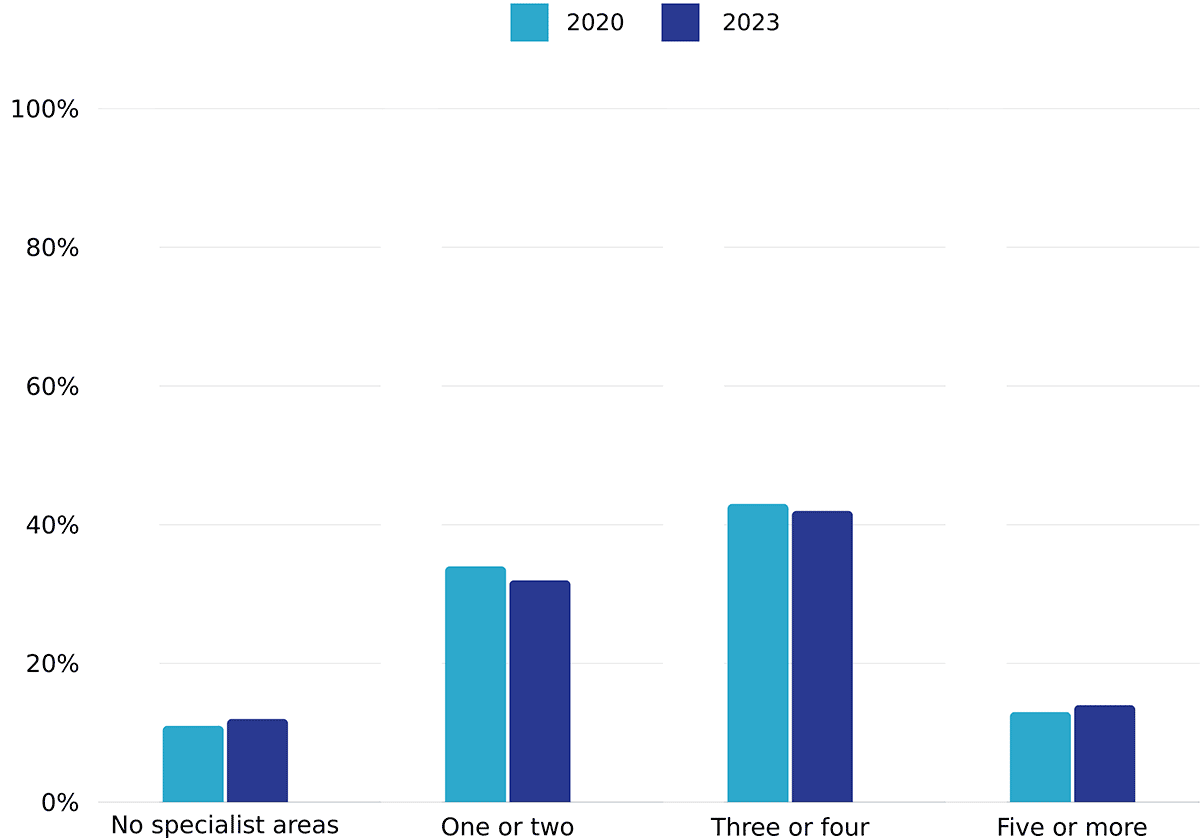
As in 2020, the most frequently mentioned specialist subject is law, with 26.5% of respondents mentioning it as one of their areas of expertise. This was followed by advertising & marketing, with 23.4%, medicine (22.3%), and business (20.7%) (Table 2)
| Area | % | n |
|---|---|---|
| Law | 26.5% | 588 |
| Advertising & Marketing | 23.4% | 518 |
| Medicine | 22.3% | 495 |
| Business | 20.7% | 459 |
52% of respondents work full-time as freelance translators
We asked respondents to specify how many hours on average they work on freelance translation (and related activities) each week. The overall distribution of responses is shown in Figure 11, and the break-down by part-time (less than 30 hours) and full-time (30 hours or more) is shown in Figure 12.
These findings are very similar to those of the 2020 survey, with respondents varying considerably in terms of their working hours. As in 2020, the largest percentage (29%) reported that they work 30 to 39 hours per week on average (Figure 11). The respondents were split roughly equally between those working full-time (52%) and part-time (48%) (Figure 12).
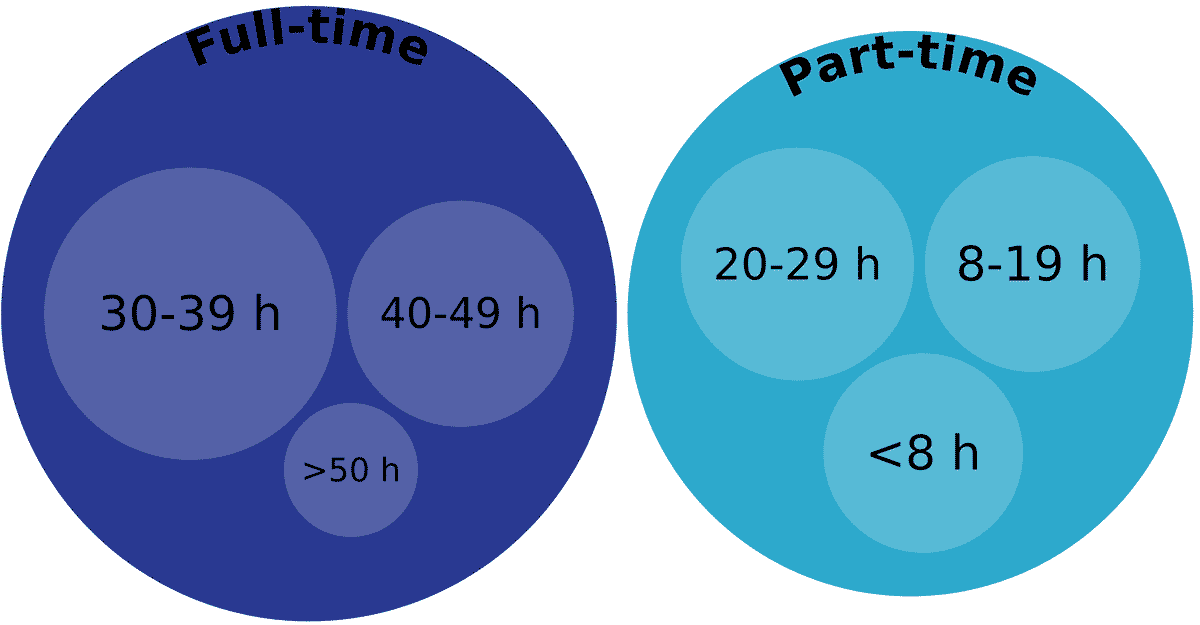
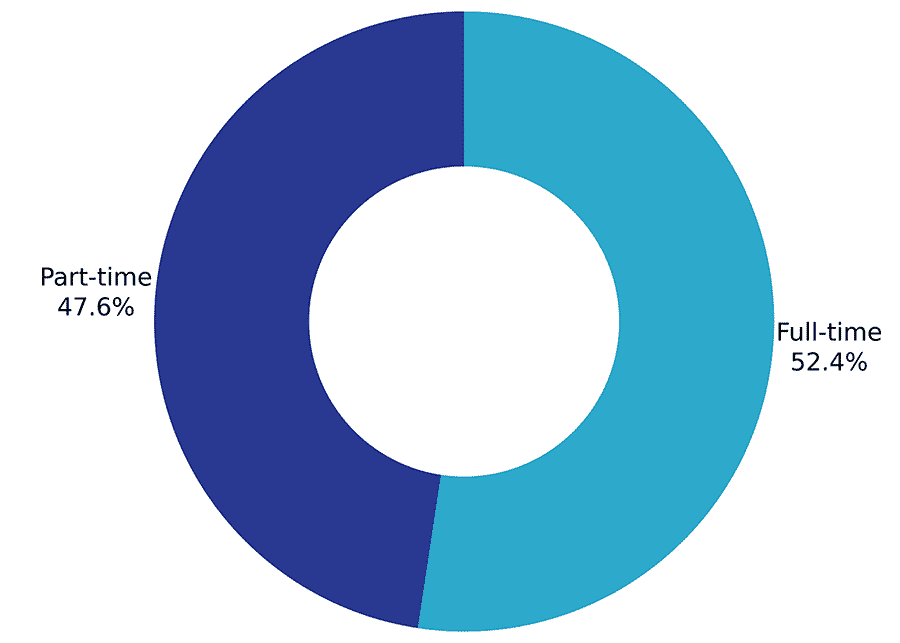
Those working less than 30 hours a week as a freelance translator were asked to indicate the main reason why they work part-time in this role, from a list of specified factors, or to provide another reason for working part-time. The distribution of responses is shown in Figure 13.

Figure 13 shows that there are a wide range of reasons why respondents are working part-time as a freelance translator. This is almost identical to the distribution of responses to this question in the 2020 survey.
Just over a quarter (27%) are reportedly doing so because they are unable to secure enough translation to be working full-time on this. Around a quarter in total (23%) of all those working part-time are choosing not to work any additional hours or are unable to do so because of health or other commitments. Another quarter (25%) in total indicated that they have another job as an employee, working either full-time or part-time, and 9% said they have another freelance job.
Of the 14% who gave “other” reasons for working part-time as a freelance translator, many of the reasons given actually fell within the other categories specified. Of the remainder, most specified that they are also currently students, others said they work part-time due to childcare or other caring responsibilities, and some specified that they are semi-retired.
In the 2023 survey, respondents who reported working 50 hours or more weekly were invited to explain why they work such long hours, and 120 (of 153 giving this response) took the opportunity to do so. Their responses fell broadly into four main categories, which can be summarised as follows:
- Necessary due to heavy translation workloads and the demands of clients
- Necessary because of the need to spend additional time on non-paying tasks such as marketing and accounting
- Personal choice – enjoying the work or wanting to earn more money
- Necessary in order to earn a sufficient amount to make ends meet or support a family.
Three times more women than men work part-time due to childcare commitments
Figure 14 below looks at the main reasons cited by women and by men for working part-time.
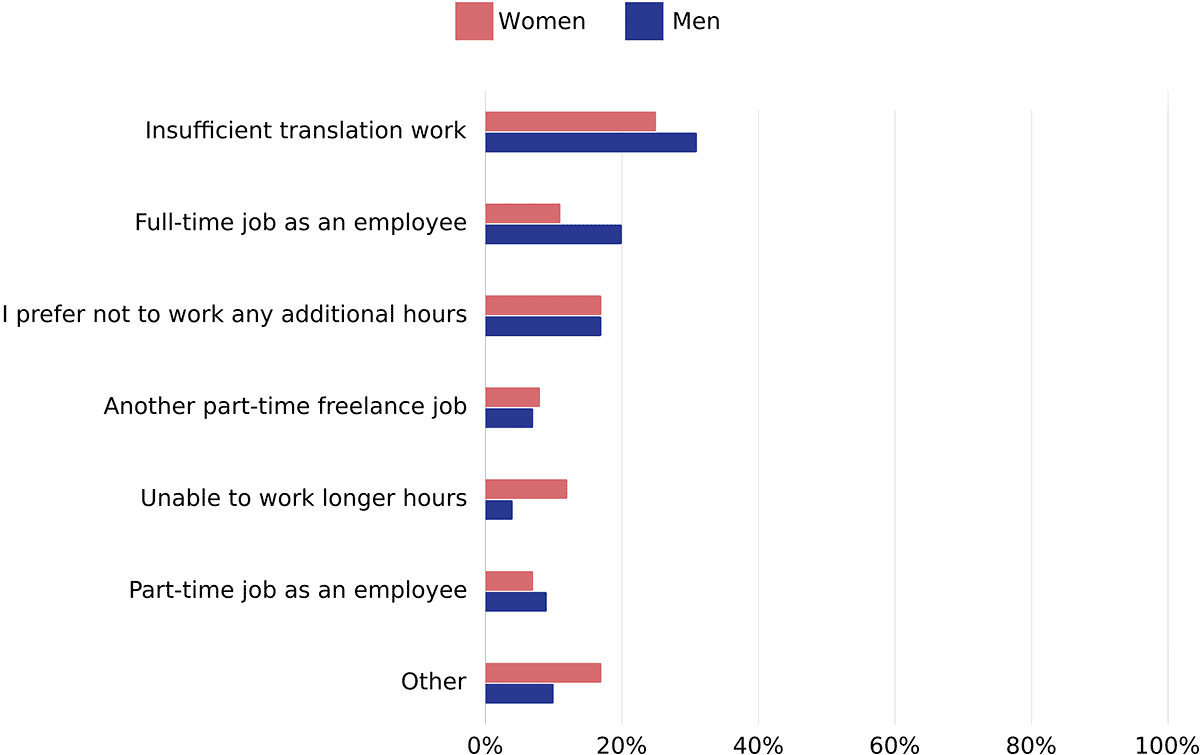
There were a lot of similarities in terms of reasons for working part-time, with the most notable differences in two areas: ‘I have a full-time job as an employee’ (11% of women and 20% of men) and the free answers in the ‘Other’ option, where 18% of women said they work part-time due to childcare commitments compared to 6% of men, and 10% are retired or semi-retired compared to 29% of men.
59% of translators use CAT tools frequently, and 19% never use such tools
The survey asked respondents whether they use computer-assisted translation (CAT) tools in their work, and the distribution of responses is shown in Figure 15. Again, the findings were very similar to the 2020 survey results: most of the 2023 respondents (81%) indicated that they use CAT tools at least some of the time, and more than half (59%) use CAT tools frequently.
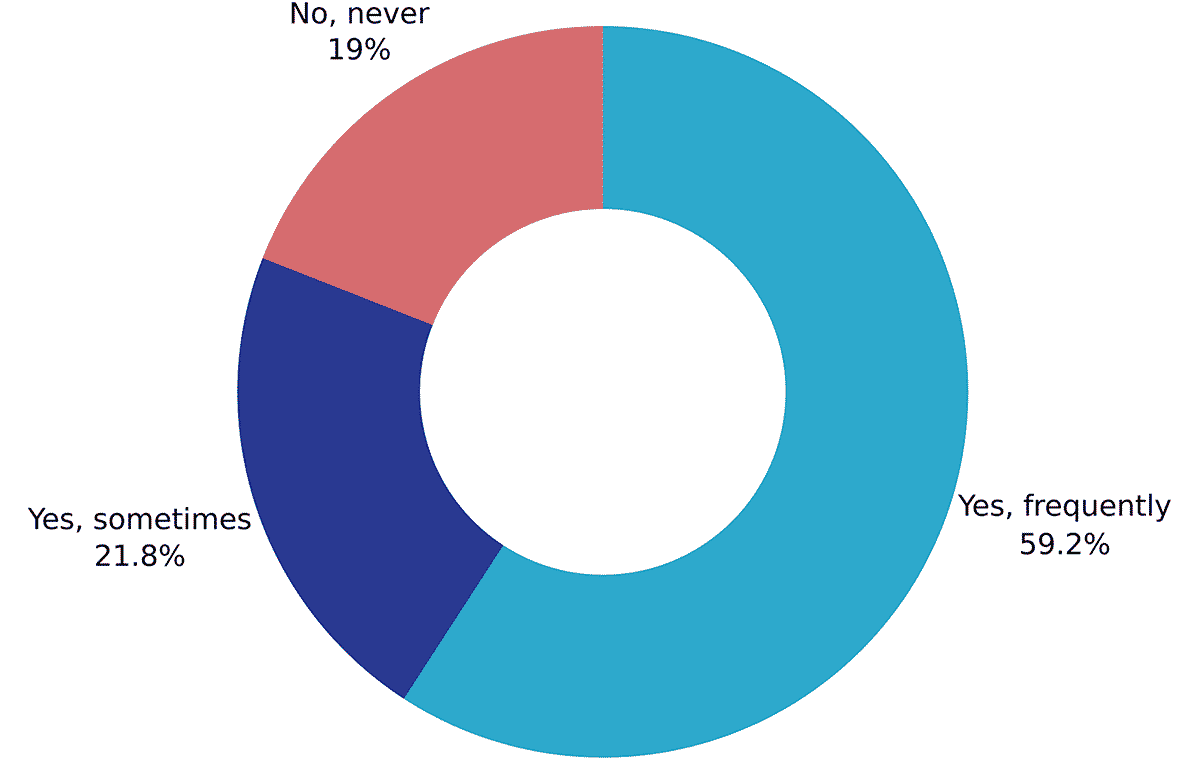
Trados and memoQ are the most popular CAT tools
We asked the respondents who use CAT tools to indicate which of a list of specific tools they use, or to specify others (they could tick all that apply). The findings are shown in Figure 16.
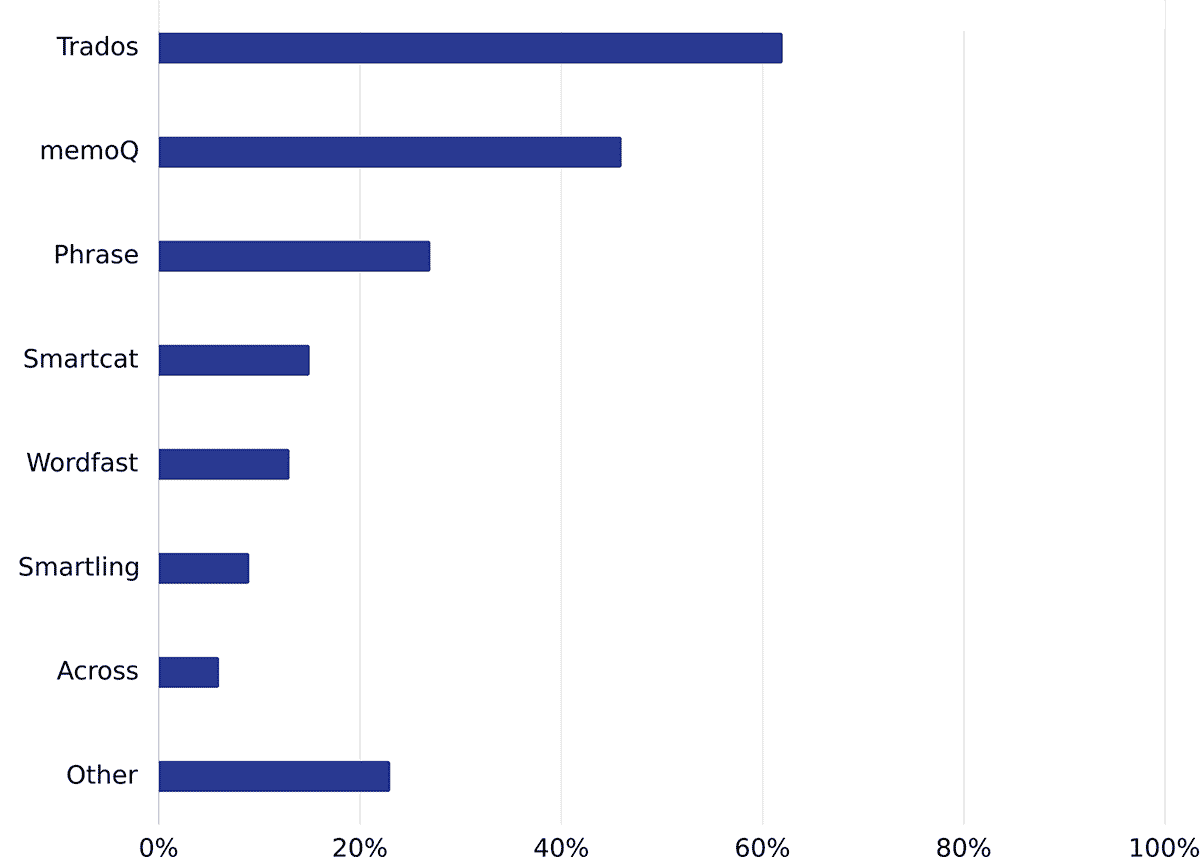
By far the most commonly used tool is Trados, mentioned by 62% of those respondents who use CAT tools in their work. This was followed by memoQ, cited by 46%. Just over a quarter of these respondents reported that they use Phrase (formerly Memsource). All other specified tools were used by 15% or less of the respondents who use CAT tools.
23% of respondents who used CAT tools reported using “other” tools (not listed), with the most commonly mentioned being XTM, OmegaT, Wordbee, and MateCat. Some translators also cited DeepL, which is not a CAT tool
83% of translators consider consistency as the main benefit of using a CAT tool
We also asked the respondents who use CAT tools to indicate up to three main perceived benefits of these. The percentages citing each factor as a benefit of using CAT tools are shown in Figure 17. The main perceived benefit of CAT tools, according to this group of freelance translators, is the ways in which they provide consistency across translations – as in 2020, this was mentioned as a benefit by 83% of those who use such tools. The next most commonly cited benefits were quality assurance features (46%) and shorter turnaround times (saving time) (45%).
A third (33%) of all respondents using CAT tools indicated that “Segmentation, it means I am less likely to miss out sentences or other parts of a document” is one of the main benefits of such tools, while 24% said that the ability to handle many different file types is a benefit.

39% of those who do not use a CAT tool say they don’t need one
Additionally, we asked those respondents who never use CAT tools to indicate the main reason for not doing so, and the distribution of answers is shown in Figure 18.
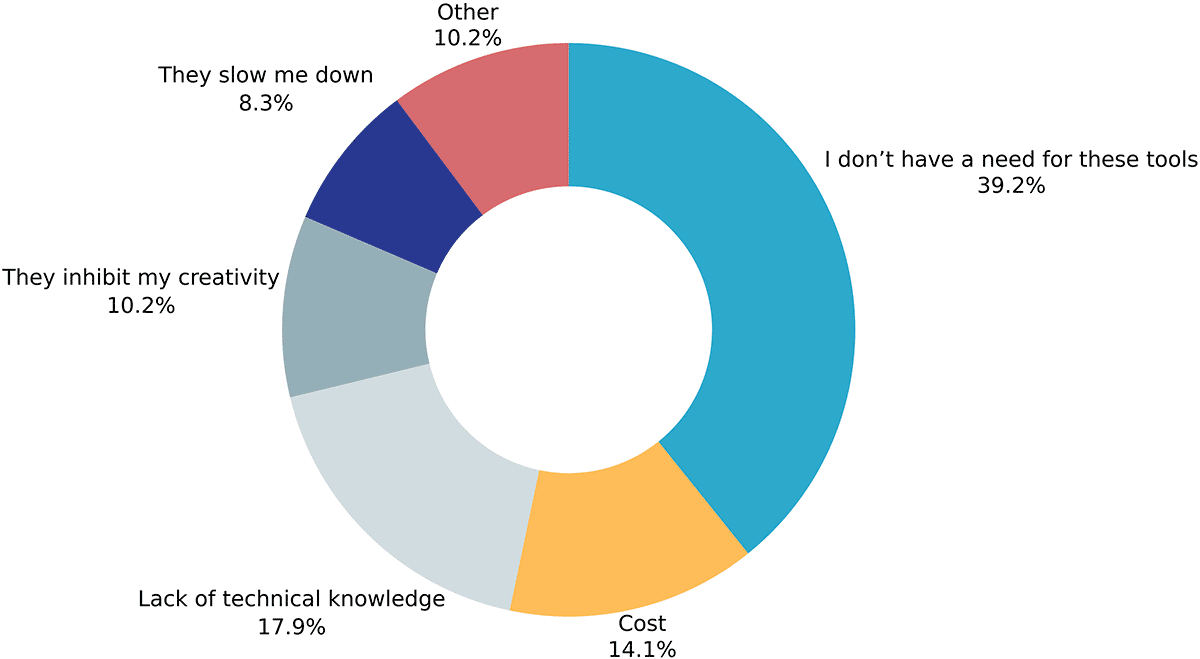
The most commonly cited reason was not having a perceived need for these tools, with 39% of respondents who do not use CAT tools giving this response. Eighteen percent of those not using CAT tools indicated that their lack of technical knowledge is the main reason why they don’t use them, and 14% cited cost as the main reason.
Refusing work
Our 2023 survey respondents were asked whether they had ever refused to carry out a translation on ethical grounds, because the text went against their own beliefs. More than half of respondents (53%) reported that they had never been offered work that went against their own beliefs, while a further 12% did not know or could not remember if they had been offered such work. In total, 35% indicated that they had previously been offered translation work that went against their own beliefs. Most of these (28%) had refused such work, while 7% had not refused it (Figure 19).
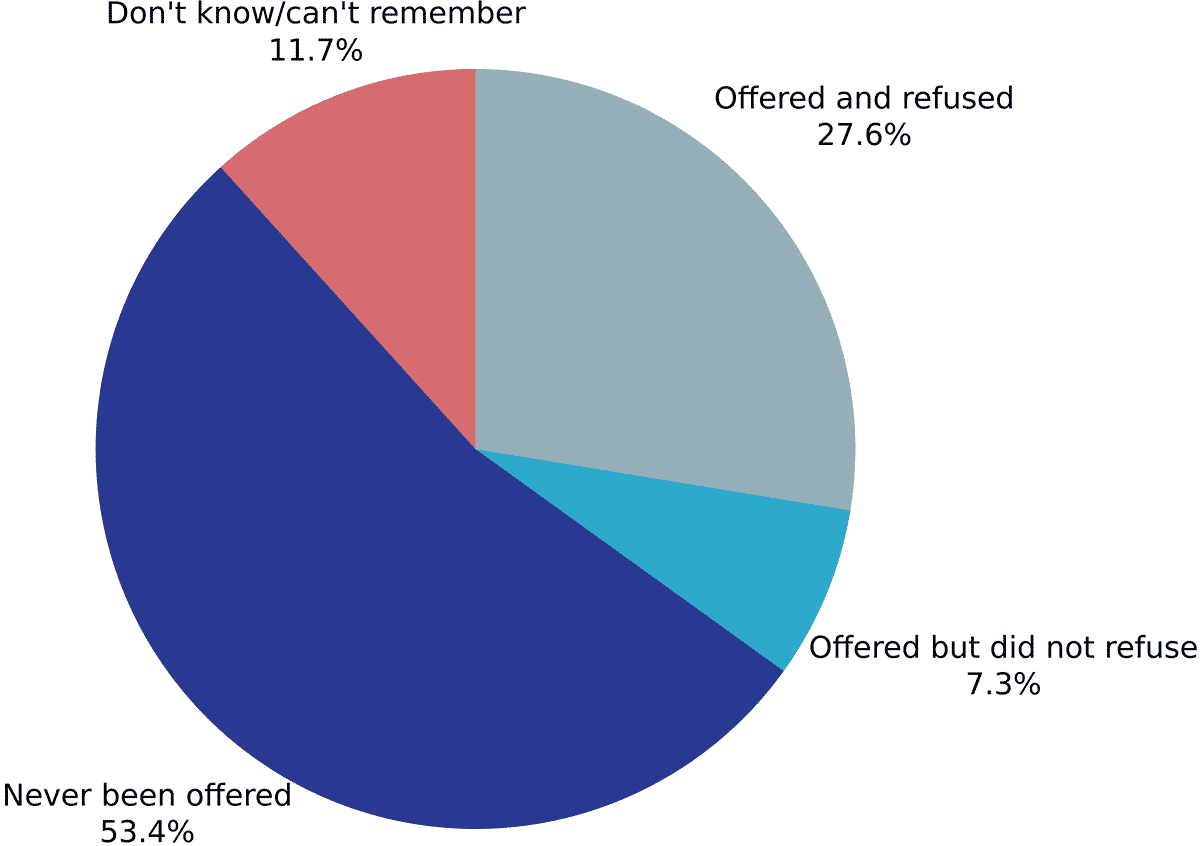
Weapons, gambling, religion and pornography are the most commonly refused topics on ethical reasons ground
Based on 495 respondents who said they refused translation work that conflicted with their own beliefs, and who answered a follow-up question, Figure 20 shows the actual numbers who said they had refused to take on translation work either in support of or against each of a number of listed topics (multiple responses allowed).
This demonstrates that the topic areas in which freelance translators have most commonly refused work for ethical reasons are weapons, gambling, religion and pornography. The vast majority had refused to work on texts that supported, rather than opposed, each of these topics.
Respondents were invited to add “other” topics that they had refused to work on in the past because they went against their own beliefs. 190 respondents answered this question, and topics mentioned included racism, terrorism, Russian propaganda, politics and hunting.
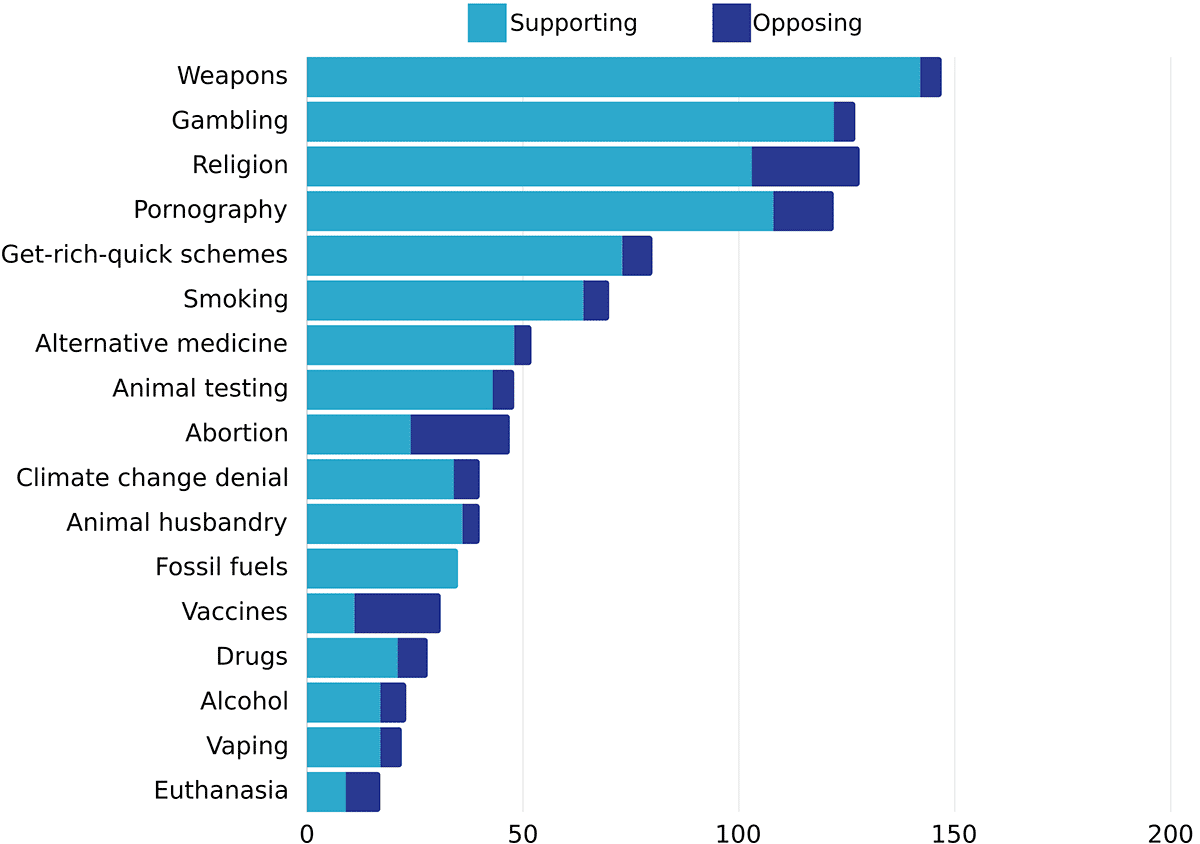
The survey also asked all respondents to indicate which of the following topics they would refuse to work on in the future, if offered work in this area that went against their own beliefs. Figure 21 shows the numbers who said they would refuse to work on the various topics listed (they could tick multiple responses).
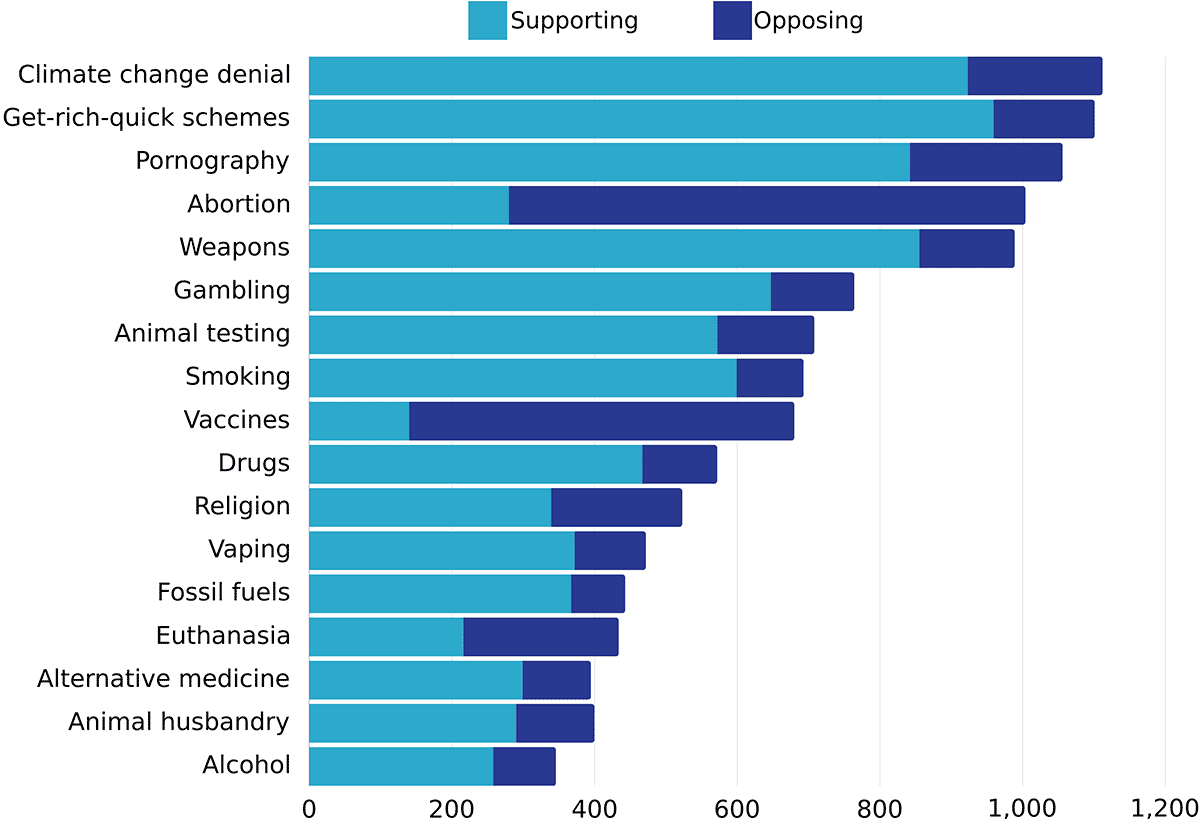
The topics that the largest numbers of respondents said they would refuse to work on were climate change denial, get-rich-quick-schemes, pornography, abortion and weapons. The majority of respondents citing each topic said they would refuse to work on texts supporting that topic. The main exceptions were abortion and vaccines, with larger numbers saying they would refuse to work on texts opposing these.
Respondents were invited to add “other” topics that they would refuse to work on. Many of the 254 who used this comment box made general comments such as “I don’t know” or “depends on the context”. Of those specifying other topics they would refuse to work on, these included extreme political content, hate speech, homophobia, racism and the Russia/Ukraine war.
The main perceived benefit of being a freelance translator is freedom/flexibility (cited by 82% of respondents)
We wanted to find out what freelance translators find most enjoyable or satisfying about their work, and what main challenges they face.
As an optional question, we therefore asked the respondents to describe in their own words what they most enjoy about being a freelance translator. 1,717 respondents answered this question and many of these mentioned several different things that they most enjoy about being a freelance translator. The main perceived benefits of being a freelance translator fell into several main themes and sub-themes, summarised below and illustrated with examples of respondents’ verbatim comments.
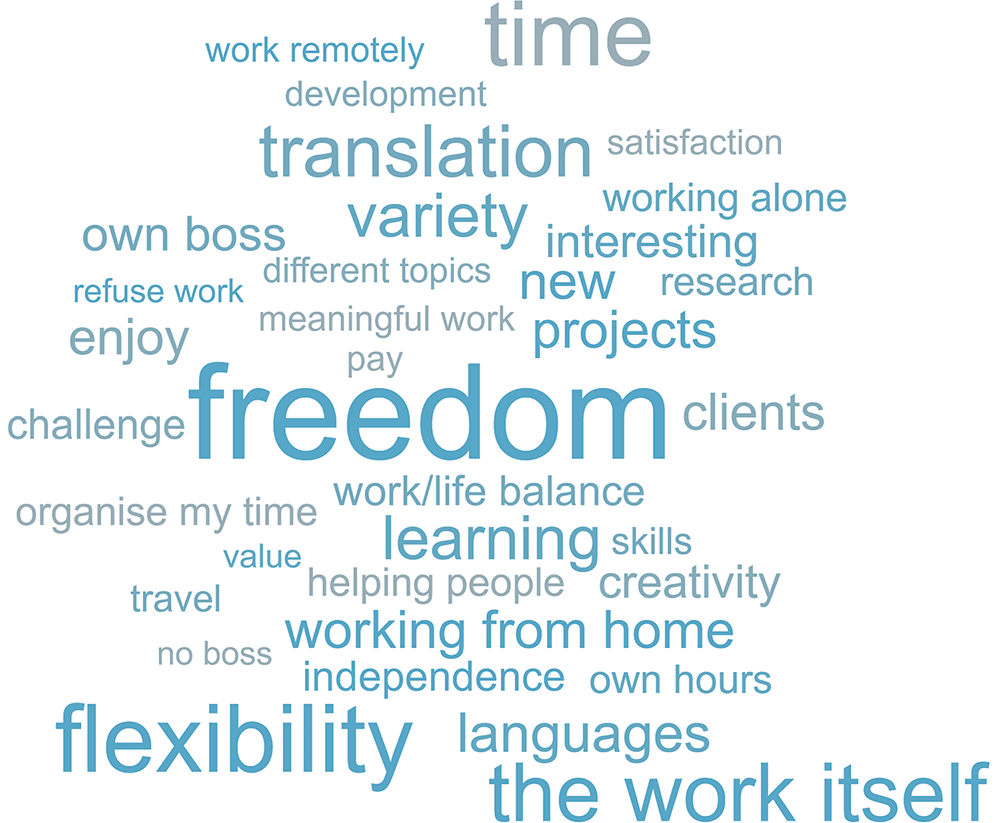
Main theme 1: Freedom, flexibility and work-life balance
This consisted of several different sub-themes, in which respondents emphasised different aspects of the types of freedom and flexibility they enjoy as a freelance translator, and/or how this enables them to achieve a good work/life balance.
In total, 1,408 respondents (82%) of all those answering this question, highlighted aspects of freedom, flexibility or work-life balance as aspects of being a freelance translator that they most enjoy. This was similar to the findings of the 2020 survey, in which the majority of respondents indicated that freedom was the thing they enjoy most about being a freelance translator, in relation to working hours or place or work and being their own boss.
In 2023, the analysis similarly revealed three main sub-themes in this category of responses, which are summarised below with illustrative verbatim examples.
Freedom/flexibility
Many respondents stressed that they enjoy various aspects of freedom or flexibility associated with working as a freelance translator, such as being able to choose their own working times or which work to accept.
“Because I can manage my own time and work according to the tasks I have and not just sitting in an office because I have to complete my eight hours, even though I sometimes work more than that but wherever I want.”
“I love the freedom to block out time for other necessary activities, such as going to the doctor or taking University classes towards a second degree, as well as the freedom to work from anywhere.”
“I can accept or reject offers depending on my availability and specialisms and the flexibility of my own schedule”
“The freedom to choose clients, how much to work, when and where to work.”
“Ability to arrange my hours around my chronic illness”
“Freedom of choosing assignments, ability to work at different times (incl. weekends and at night), having no boss who tells me what to do”
“Being able to take naps whenever I want.”
Working from home/remotely/alone
Others said that they most enjoy being able to work from home or remotely, or that they enjoy working alone. Some specified that not having to be present in an office is what enables them to engage in paid employment, others just prefer this style of working or the convenience of not having to commute.
“The flexibility of working from home means I can also perform a caring role”
“The ability to work from home, as a disability would prevent me to gain full-time employment elsewhere”
“Eating homemade meals. Sitting on sofa with my cats.”
“I get to work in pyjamas listening to music loudly”
“Work from home in a different country or in a cafe. I enjoy the silence and quiet places.”
“Not being surrounded by a noisy environment (colleagues, equipment) and noxious colleagues”
“The glorious isolation! Human contact is overrated”
“it is great to be able to work from home, set my own schedule, avoid commuting (weather and transport issues)”
Work-life balance
Finally, respondents described ways in which they most enjoy the work-life balance that being a freelance translator provides them with, either in general terms or the ways that it enables them to combine various roles and responsibilities.
“The flexibility and being able to work from home, have a career and be a Mum at the same time”
“Being able to organize my working hours around my family’s needs”
“I can work at any time of the day and make time for hobbies and leisure.”
“Freedom to structure my own routines and balance work and life”
“If you secure enough work, you can control your own time and achieve better life/work balance”
Main theme 2: Enjoyment of the work itself
In total 575 respondents, or a third (33%) of all those answering this question, mentioned aspects of their freelance translation work itself as what they most enjoy about being a freelance translator. This was similarly the second most frequently mentioned type of response given by respondents to the 2020 survey.
In 2023, further analysis revealed that the aspects of work most enjoyed by our sample of freelance translators included the actual subject matter or variety of topics and clients, the sense of being creative or challenged by the work, the opportunities for continuous learning or skills development, or the sense of purpose and meaning provided by the work. Examples of specific comments are provided below for each sub-theme.
The nature of translation work
Many respondents reported that they love translation work or their particular subject of expertise. Some just commented on their enjoyment of translation work in general, while others highlighted particular aspects of this such as the challenge or creativity involved in translating texts.
“Translating is like solving a puzzle for me, so I get to resolve problems every day in a way that is intellectually satisfying and doesn’t lead to too much frustration.”
“The translation work itself! Researching subjects/terminology, the satisfaction of crafting a TL text.”
“I love my specialist subject, it’s an amazing window into the past”
“I enjoy the work itself. I love languages, I love reading, and I love figuring out how to best express ideas from one language to another.”
“I love the research, always finding out something new. The texts are usually very interesting. I love getting new vocabulary.”
“The work itself suits my personality exactly: the need to be precise, accurate, reliable, as well as the opportunity to expand my subject knowledge”
“The unique challenges that come with each different project. They appeal not only to my language skills, but my creativity.”
The variety of work involved
Some said that they most enjoy the variety involved in being a freelance translator, with regard to the range of subjects, projects and/or clients they can work with.
“The opportunity to learn about a variety of different subjects.”
“It never gets boring as there is a constant change in topics/clients etc.”
“The variety of work together with the high level of intellectual challenge and stimulation”
“The variety of subjects. It keeps me interested and engaged, especially in research.”
“The variety of customers and topics”
Learning or skills development
Many respondents also described how they most enjoy the continuous opportunities for learning, through working on different types of projects or texts, or their continual skills development as a translator.
“I really enjoy the possibility of working on different sorts of projects all the time because I can learn about a myriad of subjects.”
“I get to learn more every day about a language and culture that fascinates me.”
“Improving my expertise all the time.”
“Before I started, I had next to no knowledge of or interest in agriculture, which is now a specialist area of mine.”
“Continually learning about new concepts, new developments, new products, and of different ways of looking at and thinking about things.”
Meaningful or purposeful work
Finally, some respondents indicated that they most enjoyed the sense of meaning or purpose they have from their work, for example when translating medical or scientific documents or more generally helping to expand knowledge or connect cultures.
“The feeling that in translating an article on medical research I may have contributed to reducing suffering.”
“I feel that my work is an extension of masterpieces and that gives a sense of purpose. Also, I help other cultures understand my own through translation.”
“Contributing to science and the wellbeing of people”
“It made me feel I had a purpose in life to bridge or connect one language to another.”
Other themes
Helping others or feeling appreciated (n=41):
41 respondents explained that what they most enjoy about their work is the sense of helping others or being appreciated by them, such as clients or those who ultimately benefit from the translation.
“I love my job, it is amazing to be able to break the barrier of language to help others, it makes life so much easier for my clients.”
“Being able to help people to communicate their ideas”
“Appreciation for my high quality of translation work”
“Bringing my expertise to the table and getting paid and respected for it.”
“Helping people who need their texts translated to improve their lives.”
“The thought that my services make my clients lives and business better and easier.”
Pay or payment arrangements
Finally, just 16 respondents reported that the pay, or payment arrangements, are what they most enjoy about being a freelance translator.
“The pay is very good”
“Reasonable pay”
“The fact that my income is directly tied to my efficiency.”
“The earnings capacity. Closely connected to the fact that every extra hour I work is an extra hour of pay.
Almost 2 out of 3 translators struggle with low rates of pay
We also asked the survey respondents what main challenges or threats they are currently experiencing as a freelance translator, if any. Similar to the 2020 survey, respondents were asked to choose up to three of various factors listed, specify others, or indicate if they are not experiencing any challenges or threats.
Five percent of the 2,347 respondents who answered this question said that they don’t experience any challenges or threats in their work as a freelance translator.
Figure 22 provides a comparison of the 2020 and 2023 findings with regard to the numbers of respondents indicating that each of the listed factors are a major challenge for them (“Knowing how to market myself to ideal clients” was asked only in 2023). The factors are ranked in descending order by the percentage of respondents citing each one as a challenge in 2023.
The findings were very similar in 2020 and 2023, with “low rates of pay” standing out as the most commonly cited challenge, experienced by 59% of respondents in both 2020 and 2023.
In 2023 this was followed by “the increasing use of machine translation” which was mentioned by 31% of respondents compared with 27% in 2020, and “difficulties in securing work”, mentioned by 30% in 2023 compared with 32% in 2020. The newly included factor, “knowing how to market myself to ideal clients” was reported to be a challenge by 27% of respondents in 2023. “Delays in payment”, cited by 22% of our 2020 survey respondents, was mentioned by just 16% in 2023.
Of the 7% of respondents who mentioned “other” challenges in the 2023 survey, these included Brexit, short delivery deadlines, the impact on work supply of the Russia/Ukraine war, and boredom.
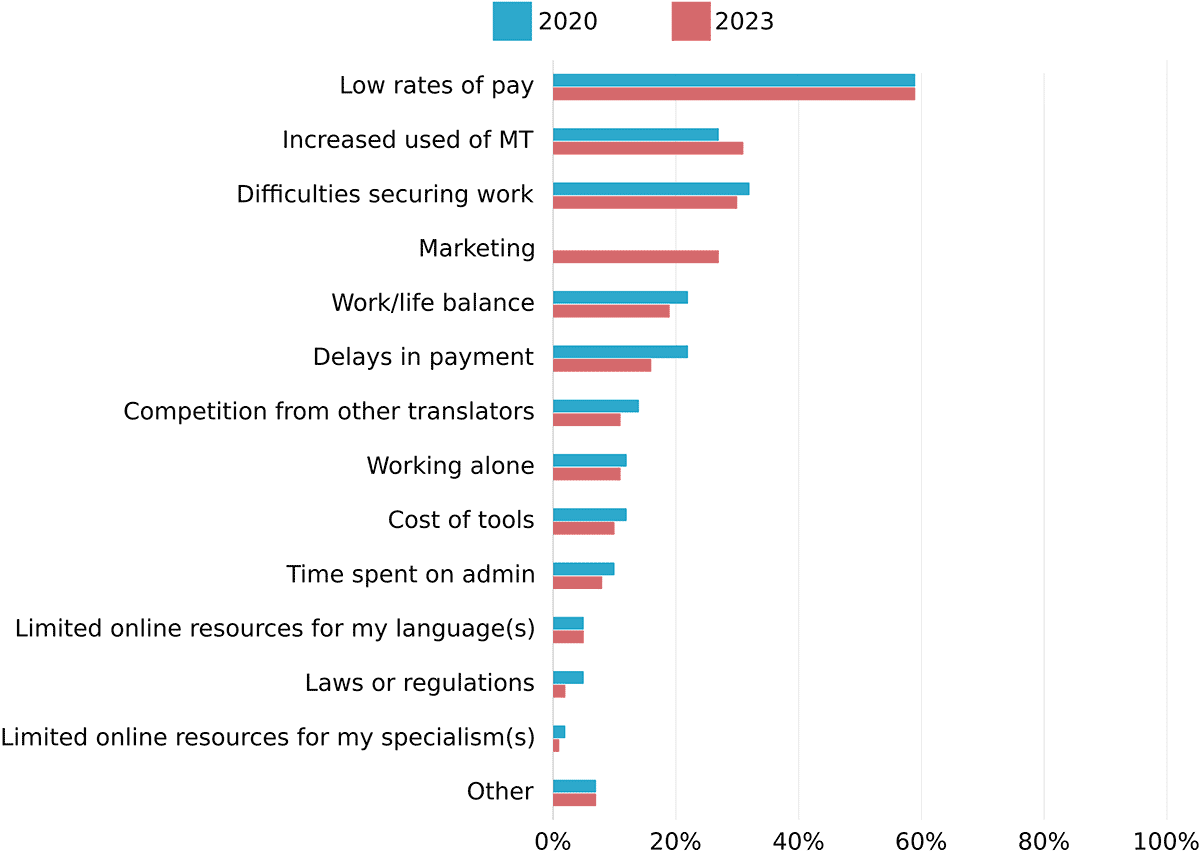
69% of translators who took part in the survey are members of a professional translation association
When we asked respondents whether they are a member of a professional translation association, 69% of the 2,318 respondents answering this question indicated that they are. This represented a considerable increase on the corresponding finding for the 2020 survey, when 47% of respondents said they belong to a professional translation association. This is an unsurprising finding, however, since the 2023 survey invitation was distributed by the ITI and other professional associations to their members.
We asked the respondents who do belong to a professional association to indicate which of a list of translation professional bodies they belong to (or specify any others). A total of 1,378 answered this question, and Table 3 shows the top 10 professional bodies in terms of the percentage who said they were a member of this body. The remaining organisations listed were cited by less than 2% of the respondents (n=<15).
| Association | Percentage | n |
|---|---|---|
| Institute of Translation and Interpreting (ITI) | 50% | 692 |
| Chartered Institute of Linguists (CIOL) | 23% | 320 |
| American Translators Association (ATA) | 7% | 102 |
| Société française des traducteurs (SFT) | 7% | 100 |
| Asociación Española de Traductores, Correctores e Intérpretes) (Asetrad) | 7% | 94 |
| Mediterranean Editors and Translators (MET) | 6% | 85 |
| Associazione Italiana Traduttori e Interpreti (AITI Italy) | 5% | 69 |
| Bundesverband der Dolmetscher und Übersetzer e.V. (BDÜ) | 5% | 63 |
| International Association of Professional Translators and Interpreters (IAPTI) | 2% | 30 |
| Associação de Profissionais de Tradução e de Interpretação (APTRAD) | 2% | 29 |
Additionally, 29% (n=394) of respondents who reported belonging to a professional translation association said that this was not listed in the survey. They were asked to provide the name of their professional association and examples mentioned by the largest numbers of respondents included the American Literary Translators Association, APTIC, ATRAE, the Irish Translators’ and Interpreters’ Association, Society of Authors Translation Association, and the Swedish Association of Professional Translators (SFÖ).
Raising awareness, advocate for rights and better rates, and more specialist training are some of the top expectations of translators from their translation associations
All respondents who belong to a professional association were invited to suggest what they’d like their translation association(s) to do or do more of. A total of 661 respondents took the opportunity to do so, though 52 of these responded by saying they were not sure or could not think of anything they’d like their professional association to do more of. Many of the remaining respondents gave more than one suggestion.
The responses were sorted into themes and sub-themes which are set out below, along with the numbers of respondents suggesting each one, and examples of the types of suggestions given.
Advocacy and outreach
In total, 186 (28%) of respondents who chose to answer this question mentioned various forms of advocacy or outreach that they would like to see their professional association carry out or do more of. These responses fell broadly into the following main categories:
Raising the visibility or awareness of the freelance translator profession (n=86)
“Push to raise standards and visibility of translators across the market.”
“Promote increased awareness and understanding of the translation process among businesses and the general public.”
“Lobby companies and government for more recognition and awareness of translation and interpreting.”
“It’s the general public and the Institutions who need to be convinced that cheap bad translations/interpretations are harmful. Translators and interpreters need to be paid fairly because their work is crucial. A ‘not so bad’ rendition of a statement in court may be the reason why someone ends up in jail or paying a heavy fine.”
“Outreach at business events to increase the visibility and credibility of translation.”
“More education of potential clients about the added value of human translation. There is so much publicity in the media about all the amazing things machine translation/ChatGPT can do (fuelled by the big businesses behind these tools), but not enough critical information on the downsides.”
“Outreach in schools and universities”
Advocate for the overall rights of freelance translators (n=61)
“Fight for better rates/working conditions, even if that means coming at odds with LSPs”
“Engage with the industry we serve to advocate for better standards and conditions.”
“Advocacy, defending translators’ rights, truly being a voice for the community”
“Address ethical concerns about certain translation practices, such as low rates, unrealistic deadlines, and inadequate quality control.”
“To be more active on social contributions/retirement issue.”
“Protect every aspect of our profession (especially regarding equal rights to medical care, education, training, with salaried employees from public and private sectors)”
“Hold agencies to account if they have a record of poor treatment of translators/very low rates (if they are a corporate member of the translation association)”
Advocate for higher rates of pay for freelance translators or help protect them from low-paying clients (n=56)
“Advocate for fairer rates with their corporate members.”
“Fight for adequate pay by hours instead of words/characters – time is the only real factor that should be considered.”
“Have a clear policy on fees that we can apply.”
“Fight our corner with regard to pricing/educating clients to aim for quality rather than low costs.”
“Fight for decent rates, with a minimum fixed for all clients.”
“Look into how rates of payment for translation work ought to be calculated. Based on worth of end product to customer? Perhaps set some benchmarks?”
“Campaign for the government to introduce procurement rules that allow greater weight to be given to quality and that would lead to higher rates and better working conditions for freelance translators and interpreters working in the public service (courts, the NHS etc.)”
“Stop giving awards to agencies that pay low rates.”
More cooperation/working together with other associations (n=10)
“I’d love associations to cooperate more with one another!”
“Closer cooperation with associations from other countries”
“To unite with the others so there would be one (or fewer) and stronger bodies”
“Engage with other translation association(s) at international level”
“To open up to collaboration with other associations outside the UK. Brexit increased the isolation of the country so belonging to a more international association would help members to expand their own business”
Training/Continuing Professional Development (CPD)
In total, 154 respondents or 23% of all those answering this question indicated they would like their professional association to provide more training/CPD, mentoring, specific types of training or more affordable/free training:
Specific types of training (e.g. subject matter or online/in-person) (n=82)
“Offer free training and refresher courses, specifically about AI in the translation industry”
“Workshops/webinars on specialisms, e.g. legal translation”
“More trainings/CPDs in the field of environment/sustainability”
“More workshops for mid-career translators as I find there’s a lot of very basic stuff but not so much that’s for those of us doing it for a while. Maybe some roundtable webinars or more opportunities to network”
“Provide subject matter training for those of us who didn’t have the chance to study translation at university.”
“I’d love an in-person advanced MemoQ course!”
“More in-person conferences and workshops”
“Online training”
More training/CPD in general (n=43)
“Seminars, continuous training”
“Offering CPD courses to younger translators”
“Provide courses and qualifications”
“Offer more webinars or courses”
Free or lower-cost training (n=28)
“More free workshops after working hours.”
“Free or cheaper CPD courses and talks”
“To offer cheaper courses/training”
“The preparation of free and interesting webinars and face-to-face courses”
“A useful free webinar every week”
Mentoring (n=9)
“Mentoring opportunities for newer translators.”
“Offer more mentoring, especially for mid-career”
“Provide interpreting mentorships”
“Creating/promoting a period of post-qualification supervised practice, as exists in other professions (e.g. doctors, lawyers)”
Advice and support
In total, 124 respondents or 19% of all 661 who answered this question suggested various forms of advice or support that they’d like their professional association to provide or provide more of. Their responses were categorised into the following sub-themes.
Help with marketing and securing clients (n=58)
“Advice or training about marketing yourself especially website/online.”
“Advice on how to find work/clients (especially when you don’t yet have experience/a specialism).”
“Advertise and promote their members to potential employers / agencies. Recommend agencies for various language combinations and type of work”
“Offer more work opportunities”
Practical resources and tools or industry information (n=27)
“Provide marketing tools in addition to the ITI directory, e.g. a website builder which is customisable and free to use for members”
“Offer free resources and support for freelance beginners”
“Provide lists of translation agencies which use certain CAT tools”
“Help produce collectively drafted and downloadable templates to send to clients regarding working conditions, average rates, emerging issues (e.g. IAI), etc.”
“Newsletters with local industry news and articles”
Guidance on translation rates and/or how to set these (n=25)
“Be able to advise on rates, currently unable due to EU laws on competition”
“Keep me updated on acceptable rates of pay.”
“Guidance re setting rates.”
“Talk about rates and markets but showing differences by language”
“Provide better guidance on how to determine fair rates.”
General advice and support (n=16)
“I’d like more support around the challenges that translators are currently facing. Brexit, the pandemic, inflation and the rise of MT have had major effects on my business and I’ve gone from earning a good living to struggling to make ends meet.”
“Support me in my start-up”
“Provide more advice about how to find work and maintain a work/life balance.”
Assistance with legislation, taxation, contracts etc. (n=8)
“Help with legislation and tax/VAT that is specific to our industry”
“Provide more information/training on how to setup a business, tax, working with clients from other countries”
“More legal/contract help”
Networking opportunities
A total of 83 respondents or 12.5% of all those who answered this question reported that they would like their professional association to provide more opportunities to network or work with other translators, with some specifying that they would like more in-person networking events, while others suggested online forums or events.
Networking (in general) or collaboration opportunities (n=56)
“Organise coworking sessions”
“Informal social media groups based on language pairs”
“Yearly sessions of collaborative weeks among fellow translators (accountability groups, challenges, etc.) to break isolation and exchange issues/experiences.”
“During the pandemic there was an real surge in exciting online activities – some of the events could be repeated even though we are “back to normal” now.”
“Meetings where we can converse about texts we’ve translated and give each other feedback, so that we’re continually broadening our arsenal of translation options.”
“Have a feature (find a colleague nearby) let’s say within 10-20 miles radius”
“We used to have a chat group, which was really valuable to feel connected with fellow translators around the world and discuss matters of importance to us. We don’t have that anymore and I think it’s a shame.”
“Help with providing opportunities to connect members with groups of direct clients e.g. by running 1 day “mixer” type events.”
In-person networking events (n=28)
“Organise/facilitate more regular networking opportunities around the country both amongst the translator/interpreter community and industry representatives that are inexpensive”
“Hold more on-site networking events.”
“Hold regional meetings more locally to me”
“In person language specific events”
“More face-to-face events in the week, rather than weekends.”
“In-person workshops throughout the year – luckily the regional associations fill this gap a lot of the time, but if you don’t live within reach of an active regional association, opportunities to meet other translators for professional development at regular intervals can be limited.”
Financial benefits
Forty-three respondents (6.5%) suggested ways in which their association could provide financial benefits to members, in the form of reduced membership fees, free or more affordable training, or discounted products or services.
Free or more affordable training (n=28)
“More free workshops after working hours”
“Offer free training and refresher courses, specifically about AI in the translation industry”
“Offer cheaper webinars”
“More affordable CPD”
Lower membership fees for all or some categories of members (n=10)
“Reduced membership rate for members on low incomes”
“Offer discounted membership fee to older members”
“Make it less costly (in terms of both money and time) to qualify for full membership. Owing to the current climate I don’t have much spare cash, nor can I currently afford to spend much time on non-fee earning work such as CPD (which is now a requirement for full membership).”
Discounted products or services (n=6)
“Decently priced liability insurance”
“Providing business supports (health and indemnity insurance) discounts”
“Members only benefit from a discount when purchasing the technology for the first time … but then they have not been able to secure benefits/discounts for those who renew their licenses or SMA yearly. That would be a nice benefit.”
Regulation and standards
A total of 57 respondents or 8.6% of all answering the question made suggestions for ways in which their professional association should do more to set or enforce various types of regulations and standards, relating for example to accreditation, qualifications, and rates of pay.
Regulation of entry and qualifications (n=42)
“Certification for first time members courses”
“Acknowledge knowledge, skills and experience of AITI members in order for them to make the transition to MITI without taking the exam”
“I’d like the profession to be more regulated, especially as regards ethics and rates, in other countries other than my own (Argentina) so that it is easier to have guidelines at a global level to help the global market”
“Regulate the field esp concerning quality and credentials”
“To put a proposal to the government to regulate the profession of a translator and interpreter so only qualified members of ITI, CIOL and TA can work as translators and interpreters.”
“Better screening of their members”
“Acknowledge knowledge, skills and experience of AITI members in order for them to make the transition to MITI without taking the exam”
Setting standard or minimum pay rates (n=17)
“Set a benchmark for fees so that there is consistency across members.”
“Regulate on pricing and pay in the industry, or at the bare minimum be more transparent about it, foster transparent discussion and start actively talking about why a profession that has to be so highly qualified, is so bleakly underpaid by agencies.”
“Claim the right to agree minimum rates”
“I’d like the association to be able to set rates for their members and have more power to punish agencies that don’t pay or have absurd payment terms.”
Better representation of the community
Twenty-nine (4%) of the respondents answered this question suggested various ways in which they felt their professional association should represent the community of freelance translators (and interpreters) better, including better support for all categories of members and making membership more affordable:
“Decide if they’re going to support freelancers or not, and make it clear what their choice is. The inclusion of corporate members makes it difficult to tell whose interests they are acting in.”
“Be better at including the particular concerns of literary translators.”
“Attach more importance to interpreting in its various forms, and not just view it as an extension of translation.”
“More help and support for upcoming translators with little experience.”
“Make more of an effort to highlight that translators from modest backgrounds should get a better shot. Accept that not all of us passed all the exams of a qualification and opted to get our hands dirty and actually – work. Think qualifications are critical? Then lobby to make translation courses and systems less punitive – stop charging translators for exam resits then you will get more ‘qualified’ people in the industry.”
Research and data collection
Ten respondents (1.5%) said they would like their professional association to do more research or data collection to generate information about their members and the translation industry.
“Do these kind of surveys, address the financial aspect of our work, ask what the real problems are”
“Yearly surveys on rates charged”
“More studies on State of the Art in Translation”
“Evaluate and provide members with more information on which way the market is going on the trends and specialization and on technology innovations”
Other suggestions
Finally, 28 respondents mentioned other things they would like to see their professional association do more of, such as:
“Promote foreign language learning in British schools”
“Closer contact with academic researchers”
“Outreach beyond world of translation and academia”
“Be more professional and up-to-date, i.e. generally more relevant and connected to the real life of translators.”
“Have a more-professional journal”
76% of translators who are members of a professional translation body consider professional recognition as the main benefit
The survey also asked respondents to indicate up to three main perceived benefits of belonging to a professional translation association, and the percentages citing each of the listed benefits are shown in Figure 23.
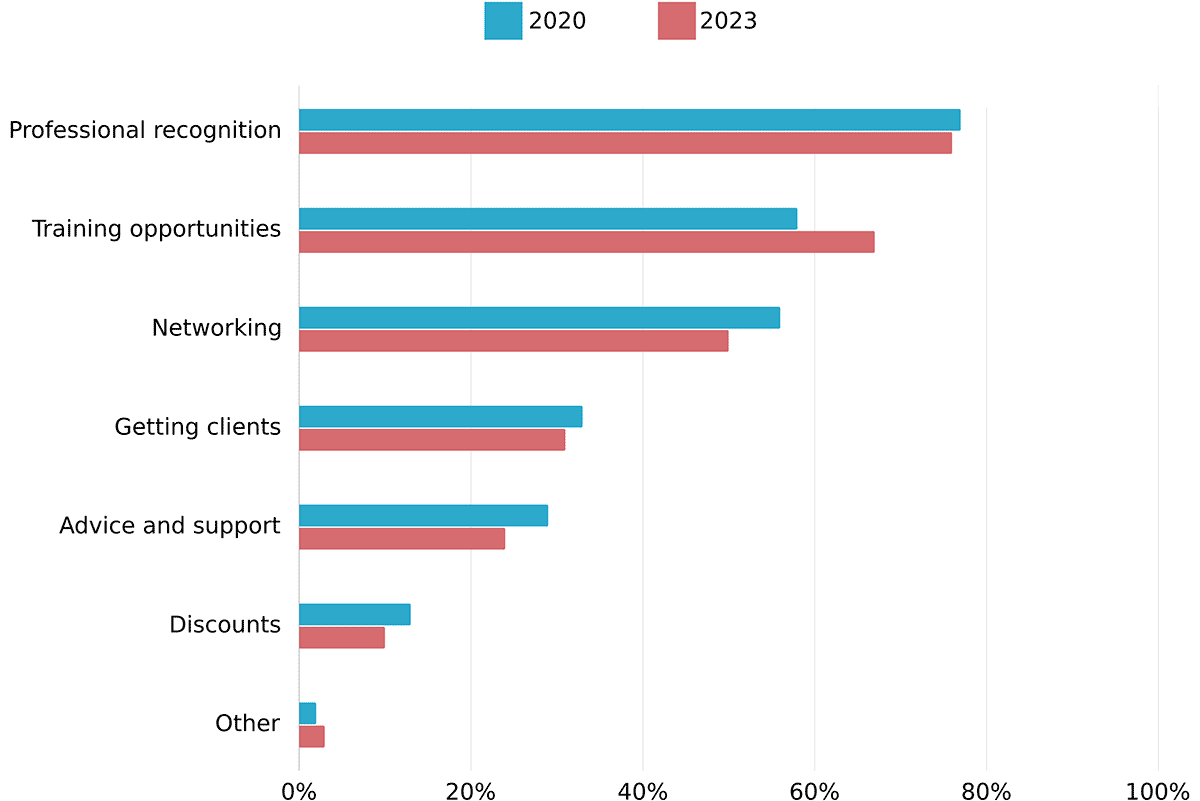
This question was also asked in the 2020 survey and the distribution of responses was very similar in both years. Professional recognition was seen as the main perceived benefit by 76% of respondents compared with 77% in 2023. As in 2020, the next most commonly cited benefit was “Opportunities for training and development”, with the percentage mentioning this increasing from 58% in 2020 to 67% in 2023. “Opportunities to network with other translators” was the next frequently mentioned, cited by 50% of respondents in 2023 compared with 56% in 2020.
As in the previous survey, smaller percentages identified as main benefits “getting clients via the members directory” (31%) and “Advice and support” (24%). Only 10% said that they view “Discounts for services/products” as a main benefit of belonging to a professional association.
Thirty-seven respondents identified “other” benefits, including for example “access to professional insurance”, “helping to raise the profile of our profession”, “information”, and “protecting our rights and working toward better work conditions”.
Unfavourable cost/benefits ratio, and no perceived benefit are the top reasons for not joining a professional translation association
We also asked those respondents who do not belong to a professional association to indicate the main reason for this, and the distribution of answers is shown in Figure 24.

Again, the findings were very similar to those relating to the same question in the 2020 survey, with almost exactly the same ranking. A wide range of factors were cited and no single factor was mentioned by more than 30% of these respondents.
As in 2020, the two reasons cited by the highest percentages of this group were “Cost/benefits ratio is unfavourable” (29%) and “I don’t perceive any benefits from this” (28%). These were followed by “Unfamiliarity with professional associations” (24%) and “I never thought about it” (20%).
Sixteen percent said that there are no relevant professional associations in their geographical area, while 14% indicated that they had been deterred from joining by the hassle or paperwork involved in the application procedure.
Only 11% of the translators don’t do any CPD
Respondents were also asked to indicate how much time they invest annually in CPD, defined as any activity aimed at maintaining and developing one’s knowledge, skills and expertise and including workshops, webinars, blogs, online or in-person training, conferences and reading. The distribution of responses to this question is shown in Figure 25
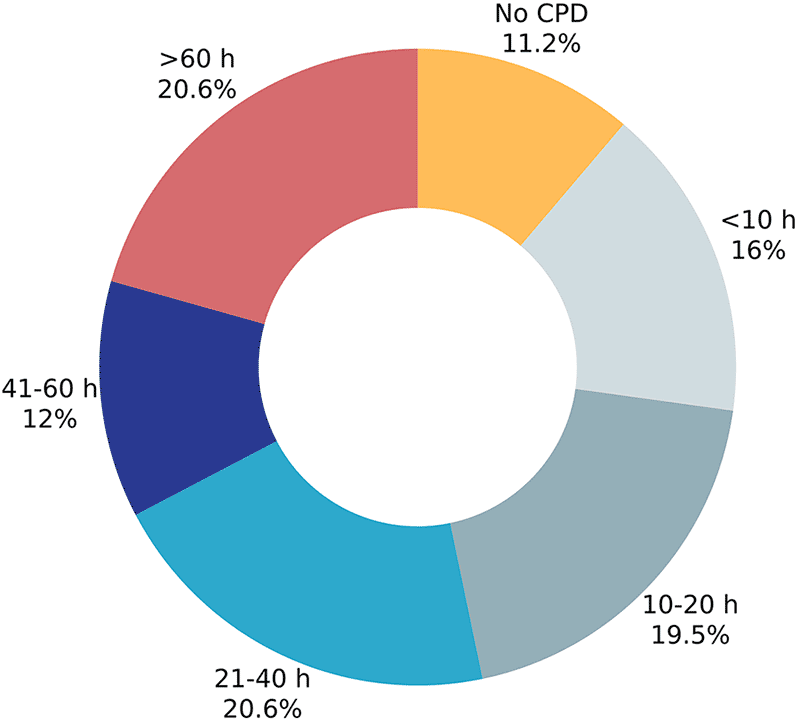
These are almost identical to the 2020 findings, and again show considerable variation within the sample in terms of amount of time invested annually in CPD. At one extreme, 11% do no CPD at all and a further 16% invest less than 10 hours on CPD annually. At the other extreme, 21% of the sample reported spending more than 60 hours on CPD each year.
We also explored the main reason why some freelance translators do not participate in CPD, and the distribution of responses to this question is shown in Figure 26.
As in 2020, the most common reported reasons for not participating in CPD were “lack of time”, with 31% giving this response compared with 24% in 2020, and not perceiving the need for this, mentioned by 29% compared with 31% in 2020. Financial reasons were mentioned by 24% of respondents compared with 28% in 2020. Of the 16% who gave “other reasons” in the 2023 survey, these included doing their own informal CPD by reading etc., having no awareness of the options, or having no interest as they will be retiring soon.
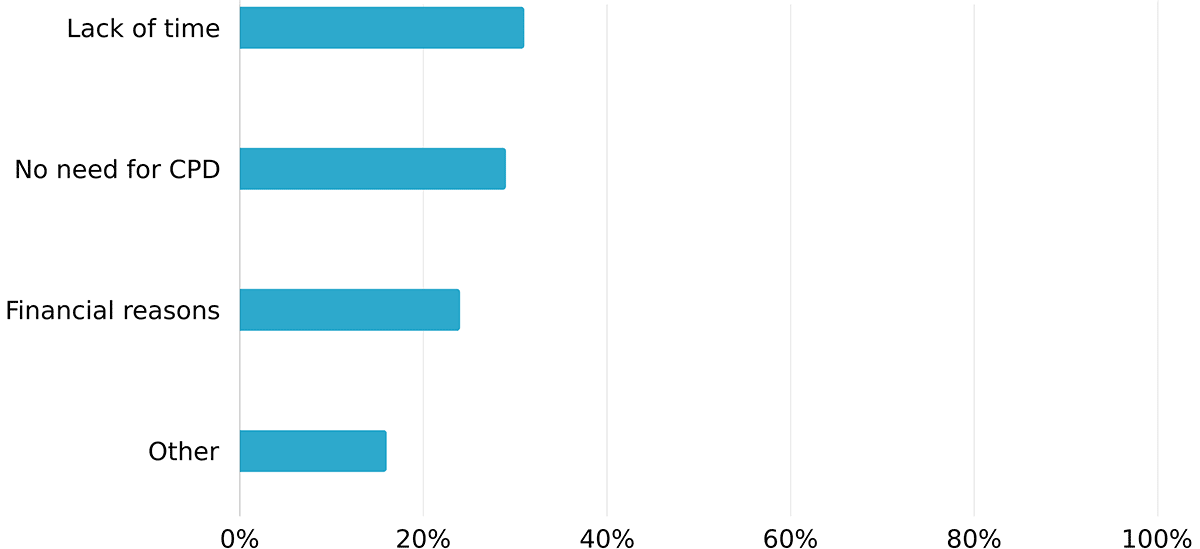
37% of women and 19% of men cite lack of time as the main reason for not participating in CPD
‘Lack of time’ was cited as a reason by 37% of women and 19% of men. Eighteen percent of women do not perceive any need for CPD, while the same reason was mentioned by 47% of men. (Figure 27)
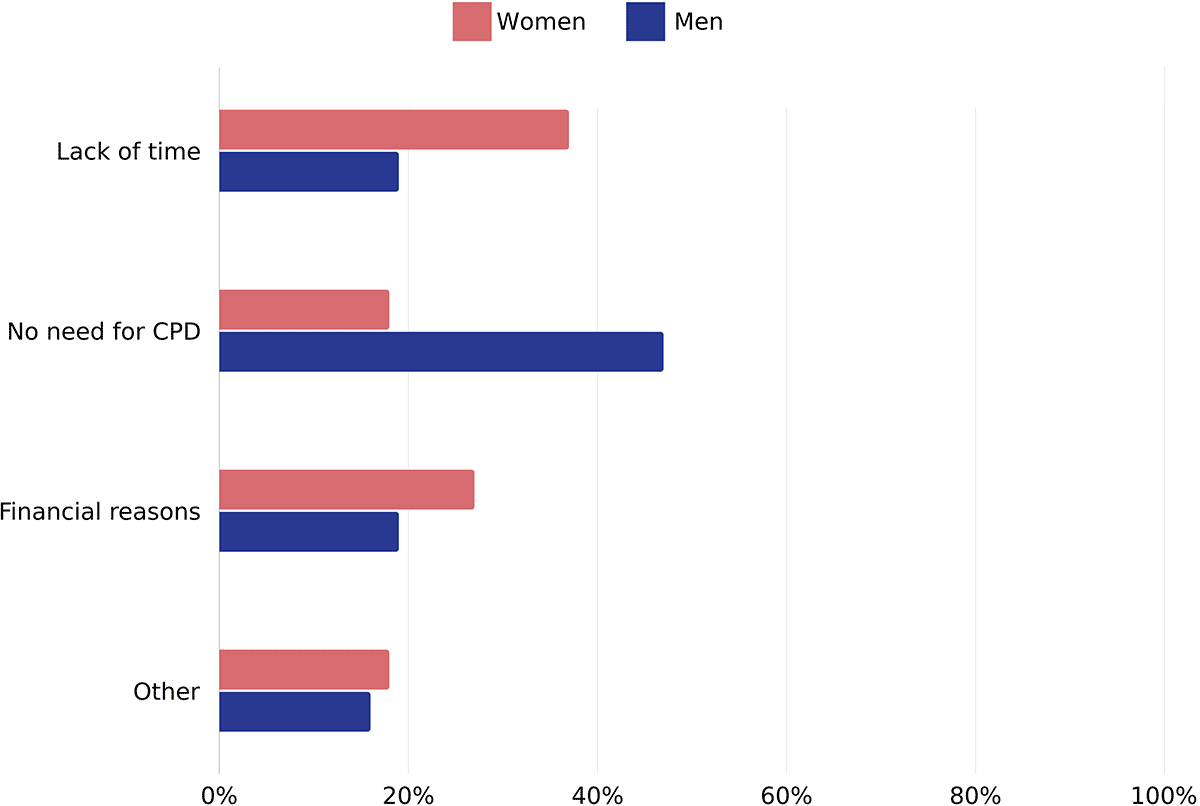
Rates and payment arrangements
Median per-word rates (GBP), regardless of language combination, are between 0.071 and 0.10, while hourly rates are between 26 and 40
Respondents were asked to consider their main language combination and to indicate their average per source word rates for translation (excluding tax), in the currency most often used.
The analysis of the rates was done by converting EUR and USD to GBP (and the results below are shown in GBP) using the exchange rate of the day the survey closed (13 March 2023). We looked at both mean and median, and, as an addition to the 2020 edition, we are presenting some of the data for the 25th and 75th percentiles.
Table 4 shows the mean, median, 25th, and 75th percentiles for per-word rates, minimum charge, and hourly rates, for agency clients (general topics and specialised) and direct clients (general topics and specialised). We also included the number of data points (n).

We also ran a number of comparisons to see if there are differences in the rates charged by women and men, freelancers who specialise versus those who do not, and translators who belong to a professional association and those who do not.
Rates for the most frequent language combinations: English into German, specialist subject, direct clients – the highest median rates at GBP 0.136 per word and GBP 53 per hour
Table 5 shows the average rates (mean and median) for the most frequent language combinations.
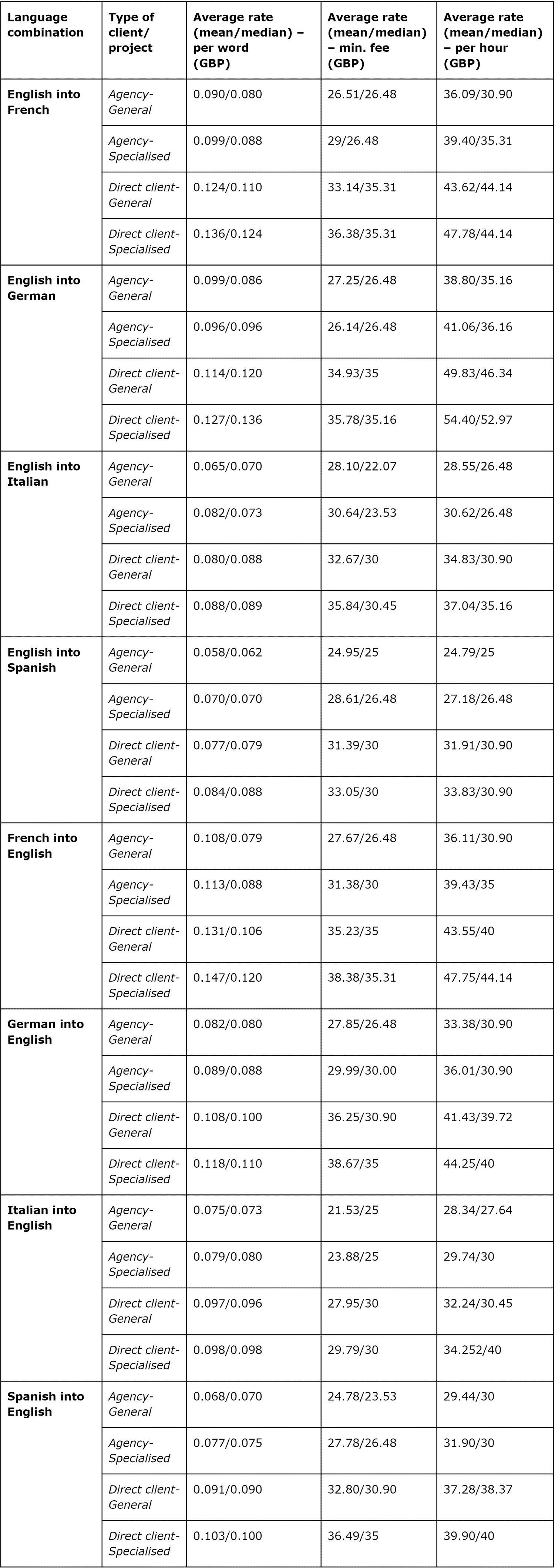
Men vs women charge almost identical rates
Unlike in 2020, where the results showed women charging slightly more than men, this year’s edition showed there are no differences in the rates charged (or they are so small they are not relevant or significant).
Translators who specialise charge up to 43% more than those who do not
Similar to the results of the 2020 survey, it looks like translators who specialise (between 1-4 areas) charge up to 43% more than those who do not specialise (20% on average, with the smallest difference noted for agency rates).
Members of translation associations charge, on average 44% more than those who do not belong to a professional body
The biggest differences in terms of rates were observed when comparing those charged by members of professional associations and those who do not belong to one. On average, members charge 44% more (between 22% and 75% more) than non-members.
16% of respondents reported a gross annual income of less than 5,000 (GBP, EUR or USD), while 2% earn more than 100,000 (GBP, EUR or USD)
We asked respondents to report on their last year’s approximate gross income from translation (including editing and revision but excluding income from other sources such as interpreting or giving courses). The findings are shown in Figure 28.
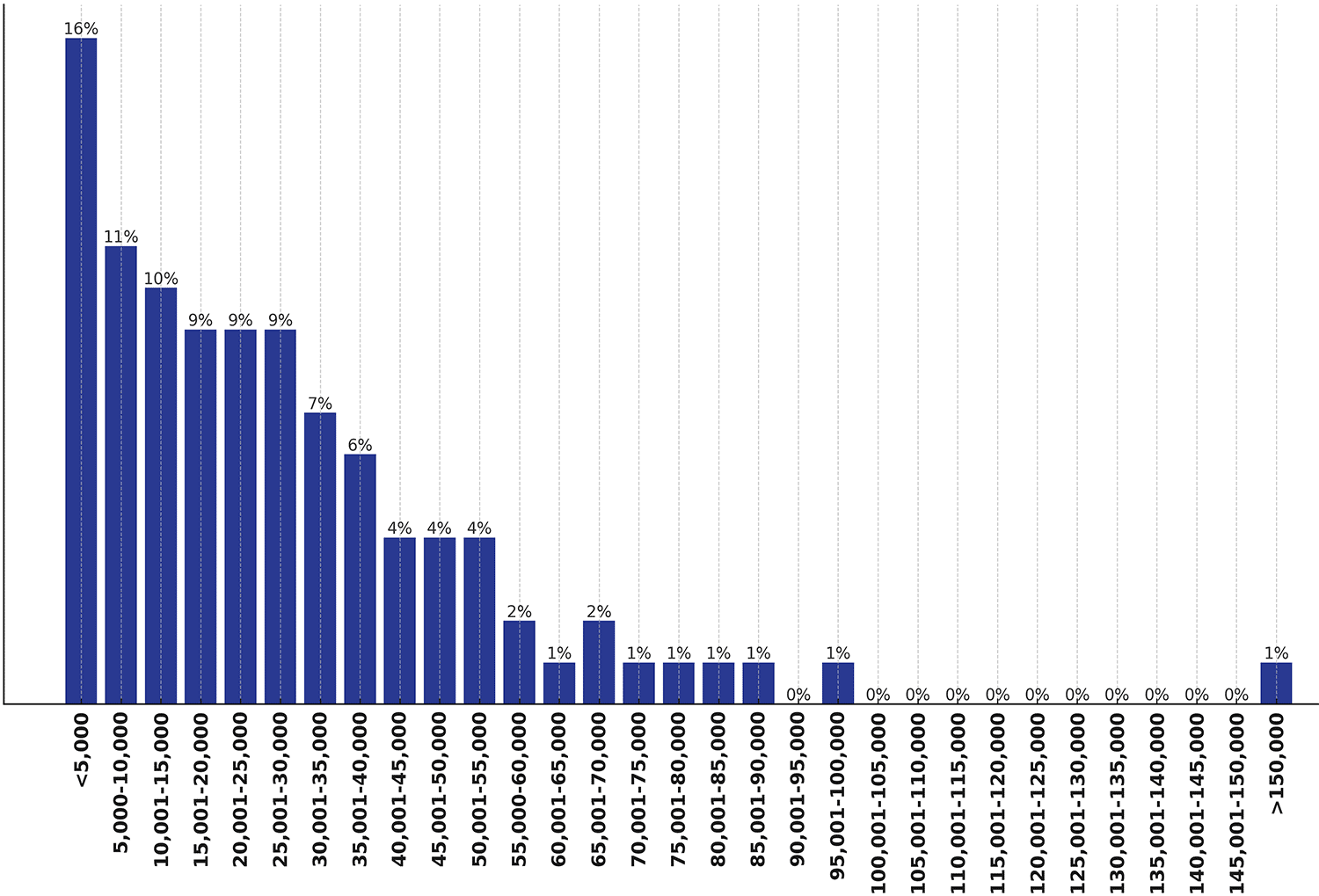
The majority of respondents (259 out of the 1,637 who answered this optional question) earn less than 5,000 pounds, euros or dollars per year, and 37 respondents earned over 100,000 in any of the three currencies.
High earners seem to specialise, use CAT tools, be members of a professional translation body, and have a website
The comparison revealed that, while there is little difference between the two groups when it comes to their role (translator only, translator and interpreter, translator and provider of other services) or education, the highest earners have more experience (92% have more than 10 years’ experience vs 41% of low earners), specialise (only 3% don’t specialise vs 18% of low earners), work full-time (with 24% reporting working 50 hours or more per week, while 38% of low earners work less than 8 hours a week), use CAT tools more (89% vs 72%), 81% of them are members of a professional translation body (while 49% of low earners are), 64% have a website (compared to 22% of low earners). More men than women are in the highest earners category, though we have to take into account the small number of respondents
It takes up to one month, on average, to get paid; private individuals are most often charged upfront
In 2023 we asked the respondents how long, on average, it takes to get paid by various types of clients, and the distribution of responses is shown in Figure 29.
This shows that translation agencies and direct clients most often make payments to freelance translators within one month/30 days, though in the case of translation agencies average payment times of up to 45 days and up to 2 months (60 days) are also common. Upfront payments are most commonly used in the case of private individuals, though there is a wider distribution of average payment times within a month for this group.
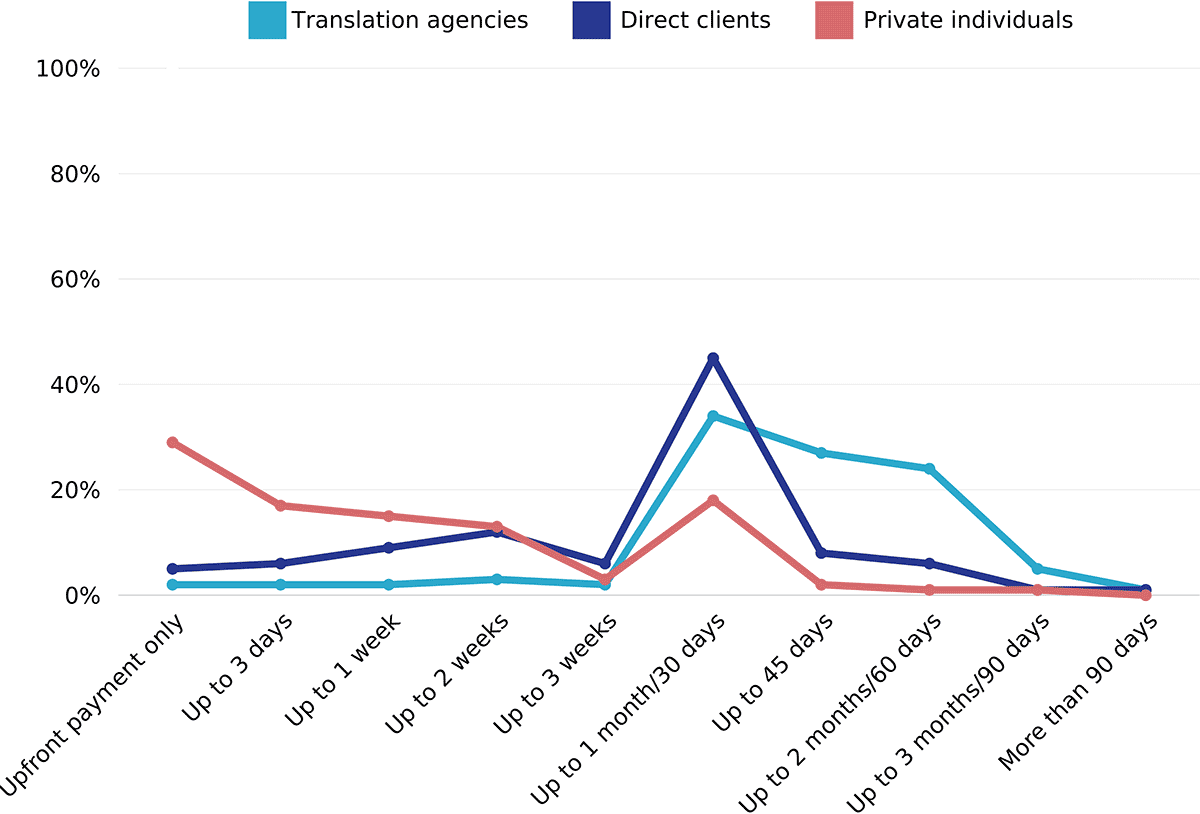
One month/30 days is the standard payment term for translators
Respondents were also asked what their standard payment terms are, if any, for each type of client, and the findings are shown in Figure 30. For both translation agencies and direct clients, the vast majority of respondents have standard payment terms of up to one month/30 days. For private individuals, up to one month/30 days and upfront payments are both most frequently used.

75% of translators apply a surcharge for urgent requests (tight deadlines), while 12% never apply surcharges
As in 2020, we asked the respondents to indicate in which of a range of specified situations they apply surcharges (multiple responses were allowed). Two additional factors were included in 2023 (“handwritten texts” and “certification”) and the findings are shown in Figure 31.
This shows that the top three most common situations in which freelance translators apply surcharges are the same as in 2020 and consist of “urgent requests/tight deadlines”, “weekend/out of hours work”, and “heavy formatting”.
Compared with 2020, when 59% of our survey respondents said they apply surcharges when asked to take on urgent work or meet tight deadlines, 75% gave this response in 2023. Slightly smaller increases were observed in the percentages applying surcharges for weekend/out of hours working, from 49% to 56%, and for heavy formatting, from 42% to 49%.
The two items included in the 2023 survey for the first time came next in the ranking of situations when surcharges are applied, with 40% saying they use these when asked to work on handwritten texts, and 25% for certification. Just twelve percent of respondents said that they never apply surcharges, compared with a corresponding figure of 21% in 2020. Of the 4% (n=69) of respondents giving an “other” response, examples included working with complex material, having to read a lot of instructions or reference texts, and when clients are difficult to work with.
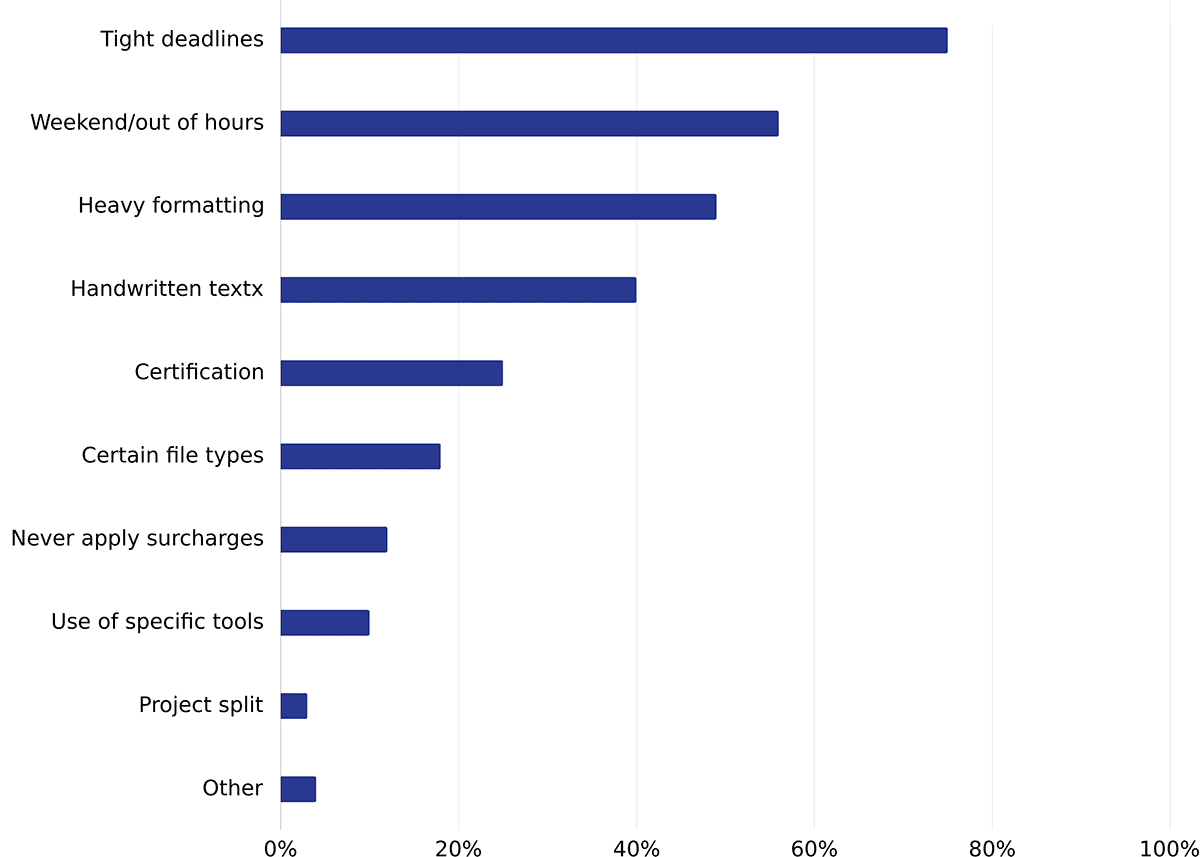
52% of translators apply a discount for repetitions, while 19% never offer discounts
In 2023 we introduced a new question asking in which of a number of listed situations, if any, the respondents apply client discounts, and the findings are shown in Figure 32.
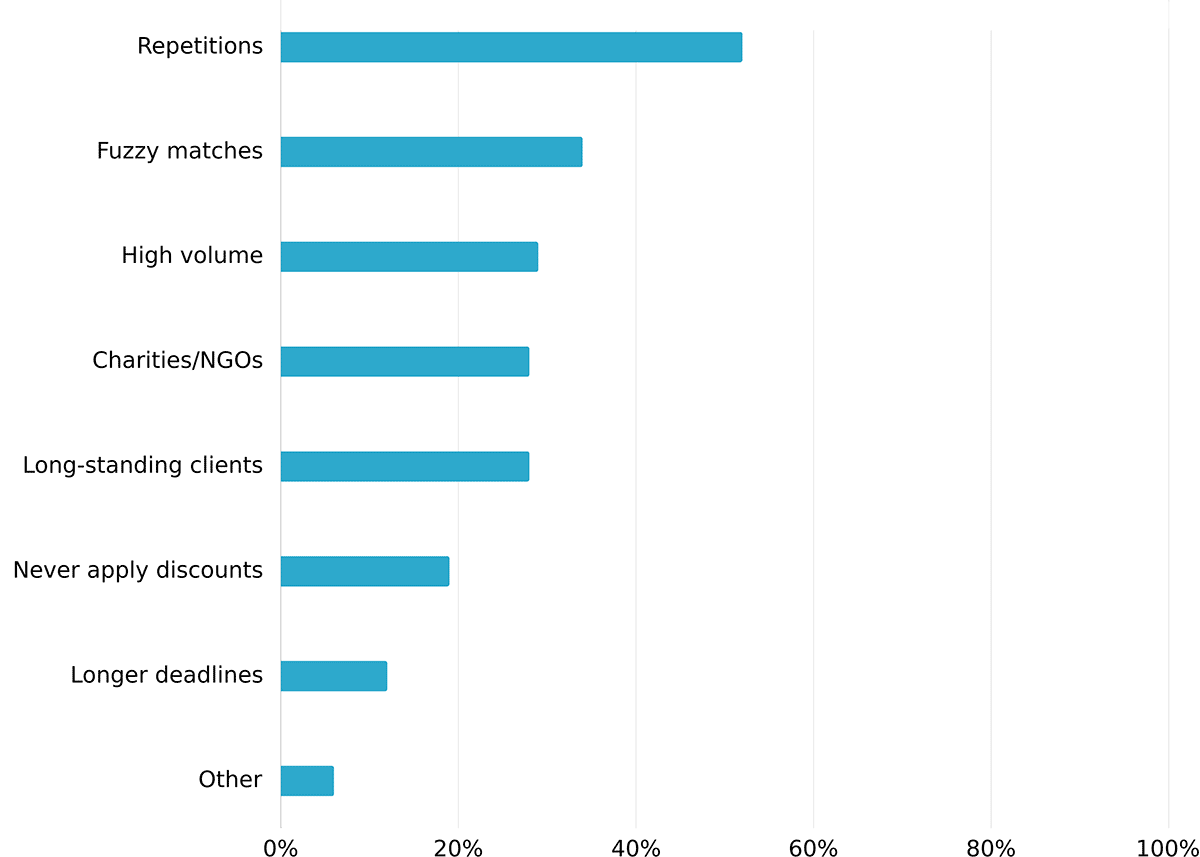
The most common use of discounts is for “repetitions”, with more than half (52%) of respondents reporting that they apply discounts for this type of work. This was followed by “fuzzy matches” (34%), high volume of work (29%), work for charities/NGOs (28%) and long-standing clients (28%).
Translation agencies ask translators to lower rates much more frequently than other types of clients
Figure 33 shows the distribution of responses to the question “How often have you been asked to lower your rates by agencies or direct clients?”, for those respondents who have each type of client.
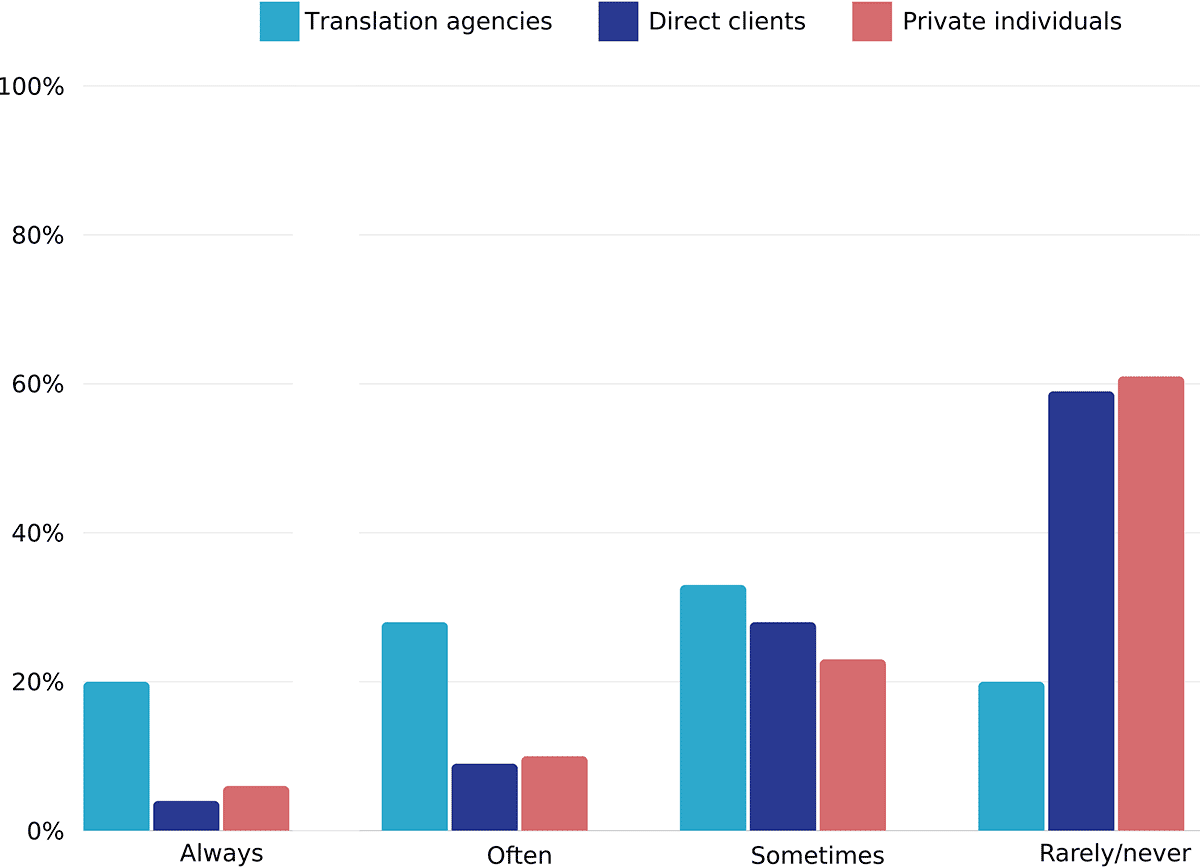
This shows that most respondents with these kinds of clients say that direct clients (59%) and private individuals (61%) rarely or never ask them to lower their rates, though 28% of those with direct clients report that these sometimes ask them to lower their rates and 23% of those with private individual clients report that they sometimes ask them to lower their rates. Just 13% say that direct clients often or always/nearly always ask them to lower their rates and 16% gave one of these responses for private individual clients.
In contrast, a total of 48% of those respondents who work for translation agencies reported that these always or often ask them to lower their rates, and 33% said that they sometimes do this. Just 20% of respondents who work for translation agencies said that these rarely or never ask them to lower their rates.
The majority of translators (75%) do not charge different rates based in the client’s geographical location
The survey also asked whether the freelance translators ever charge different rates based on the client’s geographical location. Of the 1,766 who answered this question, 75% said that they don’t charge different rates based on geographical location, while 25% said they do.
Those respondents who do charge different rates based on the client’s geographical area were then asked to indicate whether, for listed geographical areas, clients are charged lower, standard or higher rates (for those with clients in these areas). (Figure 34).
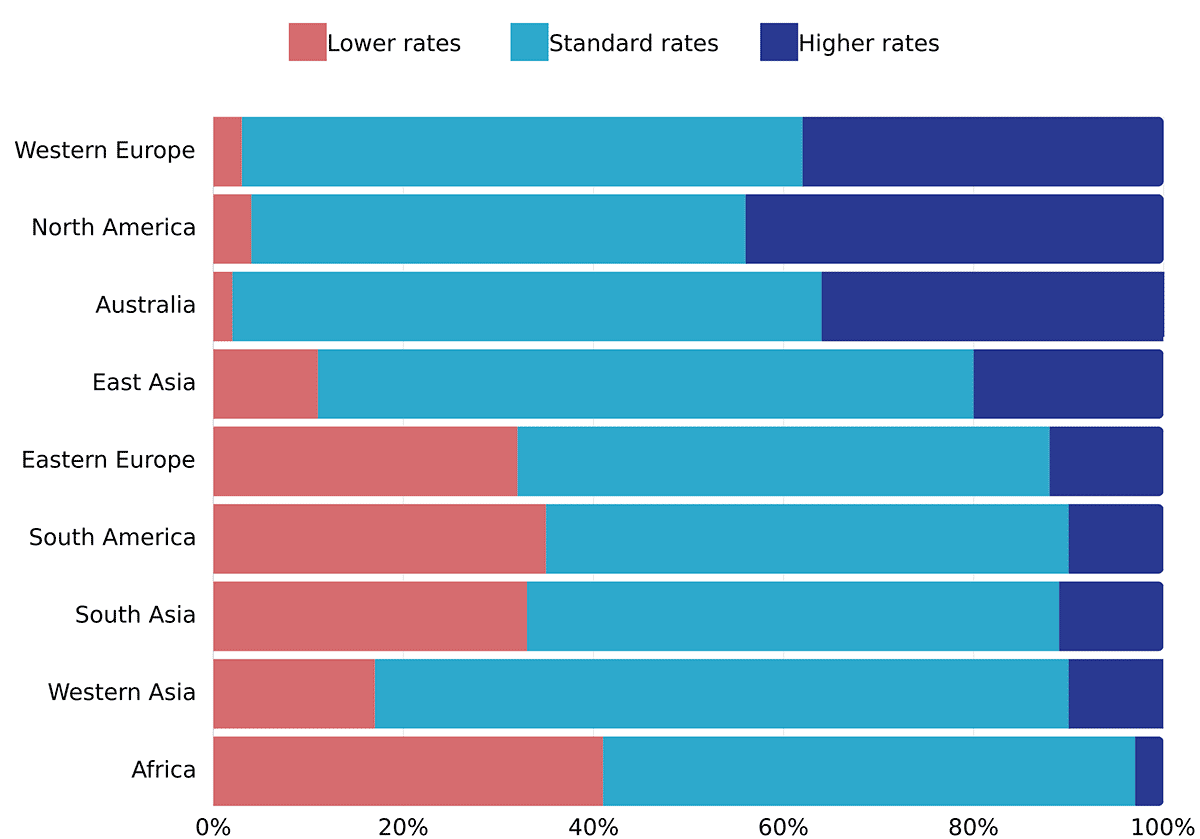
This shows that, of those respondents with clients in the specified areas who charge different rates based on geography, relatively high percentages charge higher rates to clients in North America (44%), Western Europe (38%) and Australia (37%). In contrast, relatively high percentages charge lower rates to clients in Africa (41%), South America (35%), South Asia (including India) (33%) and Eastern Europe (32%).
As an optional question, the survey also asked, “Excluding surcharges for things like tight deadlines or working outside standard business hours, do you ever charge different rates to different clients for the same service, based on criteria other than their geographical location?” A total of 1,680 respondents answered this question and 65% said that they do not charge different rates based on criteria other than geographical location.
The 35% (n=591) of respondents who indicated that they do charge different rates based on other criteria were asked to specify what these criteria are. Examples of the answers given included perceived client budget, subject matter, project complexity, size of client organisation, and prior experiences of late payment from the client.
78% of freelance translators charge by the word
We asked respondents how they usually charge for their translation work, and the distribution of responses is shown in Figure 35 for the 1,753 who answered this question (respondents could select more than one answer).
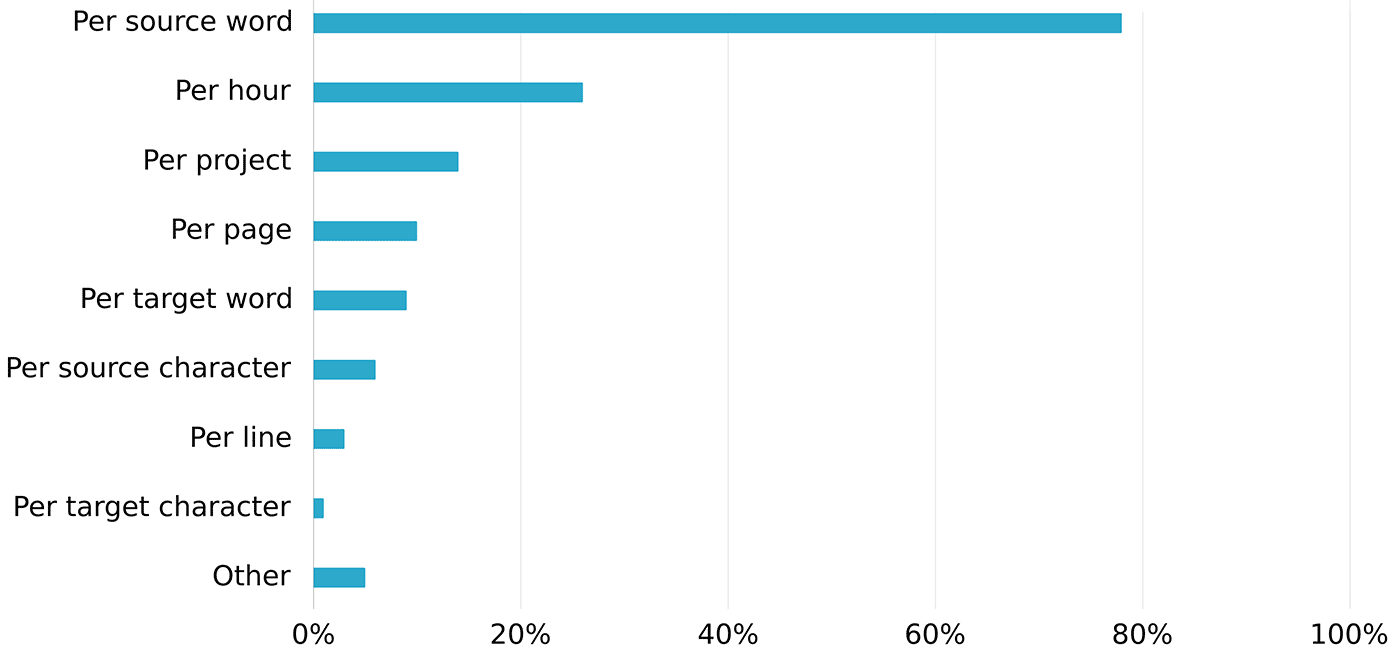
This shows that the vast majority of freelance translators charge by number of source words (78%). Around a quarter of respondents (26%) charge by the hour, and 14% on a project basis. Other methods of charging were reported by 10% or less of respondents.
In an optional question, those who reported that they charge on a per-project basis were also asked to explain in their own words how they calculate the total fee for that project and 169 took the opportunity to do so. Most reported that they start from the word count and/or the estimated time it will take, then add various factors such as the deadline, extras (review, project management), formatting, or value to the client. Some also mentioned adding a percentage as a cushion.
Some examples of their answers include:
“It is usually based on suggested per-page/per-word prices set by my translators’ association (for most direct clients and private individuals). Then I factor in any surcharges or discounts, as well as whether I have to take care of printing and legalizing certified translations, for example, or block out time I was thinking of devoting to another project”
“I begin with the word count, then try to work out how long in hours it will take to do any extras, including formatting, communications with the client, etc.”
“The amount of hours I estimate it will take calculated on the amount I’ve worked out that I need to earn per hour for my average working week.”
“Estimated hours of work involved”
“Based on the complexity and overall volume of work”
“I take into account the word count, deadline, formatting, topic.”
“How specialist is the text? How creative do I need to be? Is it a normal translation or a track changes project? Are there any other rounds that might happen in the future?”
Most translators do not increase their rates regularly or haven’t increased them in more than 3 years
In the 2023 survey we also asked how often, if ever, the respondents increase their rates and the distribution of responses is shown in Figure 36.
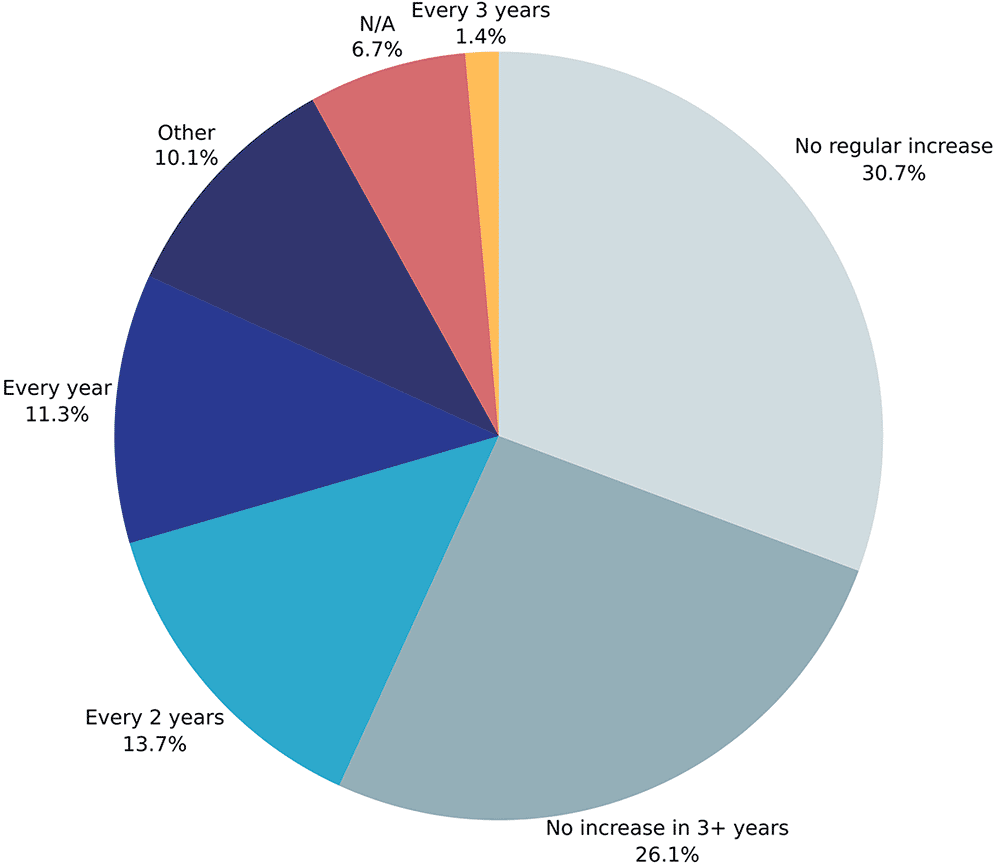
This reveals that most freelance translators surveyed have either not increased their rates in more than three years (25%) or do not increase them regularly (29%). Just 13% of the respondents who answered this question reported that they increase their rates every two years, and 11% do so every year.
Inflation was the main reason for increasing rates, cited by 49% of translators who reported that they increase their rates regularly
Those respondents who reported that they increase their rates regularly were asked to indicate the main reason for doing so, from a list of specific factors (they could only specify one). The distribution of responses is shown in Figure 37 for the 535 respondents who answered this question.
This shows that inflation is the main reason for regular rate increases for around half of these respondents (49%), with the second most commonly cited factor being their increase in experience over time. Sixteen percent did so mainly as they regard this as good business practice, and 7% because of high demand for their services.

When increasing their rates, translators do so selectively (not for all clients)
The respondents who regularly increase their rates were also asked whether they do so for all clients or only some, such as new clients or those already on the lowest rate. Just 33% said they increase rates regularly for all clients while 67% said they do so selectively for just some clients.
The main reason for not increasing their rates is the fear of losing clients
We also asked the respondents who have not increased their rates in more than three years or do not do so regularly what the main reason for this is. The distribution of findings is shown in Figure 38.
The majority of these respondents (62%) said that they don’t regularly increase their rates (or have not done so for more than 3 years) because they don’t want to lose clients, while 18% indicated that they are happy with their current earnings.
Twenty percent of these respondents gave “other” main reasons for not increasing their rates, which included for example clients being resistant to rate increases, a declining supply of work even at current rates, the belief that rates are fair and reflect the market price for translation services, and rates being set by the client rather than the freelance translator.

Working with clients
The vast majority of translators (83%) work with translation agencies
In 2023, 83% of our respondents reported that they work with translation agencies, a slight increase from 79% in 2020.
The main perceived benefit of working with agencies is that translators do not need to worry about client acquisition
Those who work for translation agencies were asked to cite up to three main benefits of working with translation agencies, and the percentages citing each factor are shown in Figure 39.
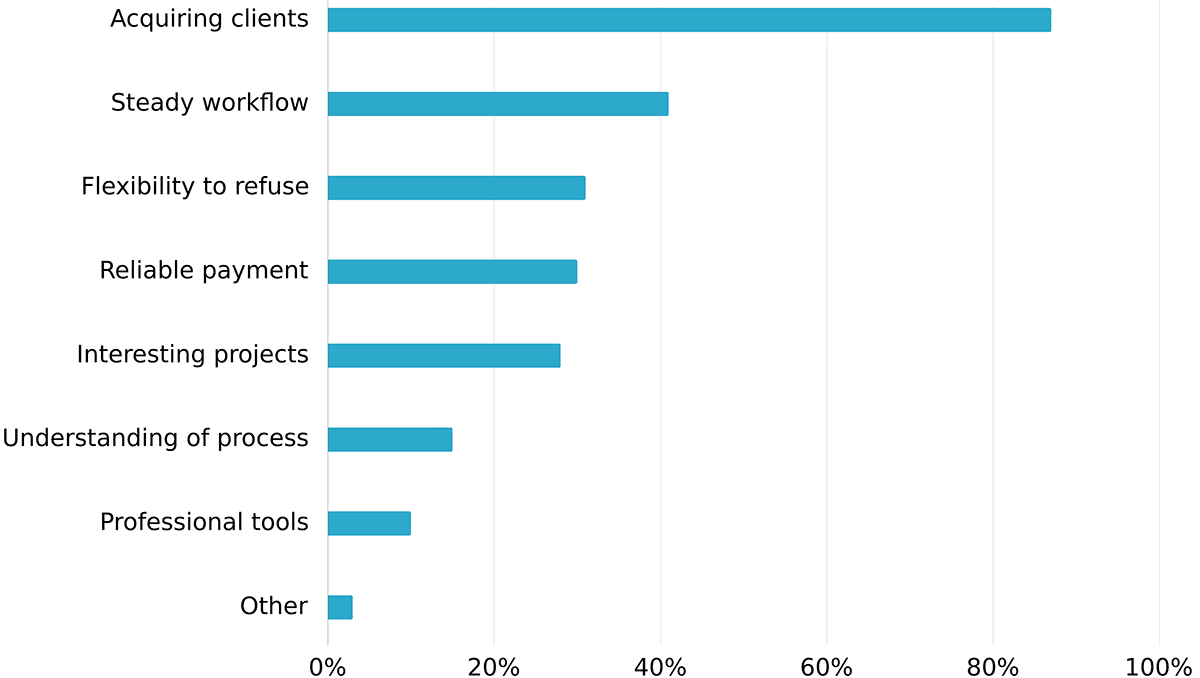
The most commonly perceived benefit of working with translation agencies is that this allows the translator to focus on working rather than client acquisition and other tasks such as project management and file preparation. This was cited as a benefit by 87% of all those who work with translation agencies. Thirty-one percent of respondents who use translation agencies see “steady workflow” as one of the main benefits of doing so, 30% said that “reliable payments” are one of the benefits, and 28% like the opportunity of being able to work on “interesting or varied projects”.
71% cited low rates of pay as the main challenge when working with agencies
Respondents who work with translation agencies were also asked to indicate up to three challenges or difficulties they experience when doing so, or to indicate if they do not experience any challenges or difficulties when working with agencies. Just 6% (n=81) of the 1,448 respondents who use translation agencies and answered this question said that they do not experience any challenges or difficulties when doing so. The percentages indicating that they experience each of the listed challenges or difficulties are shown in Figure 40.
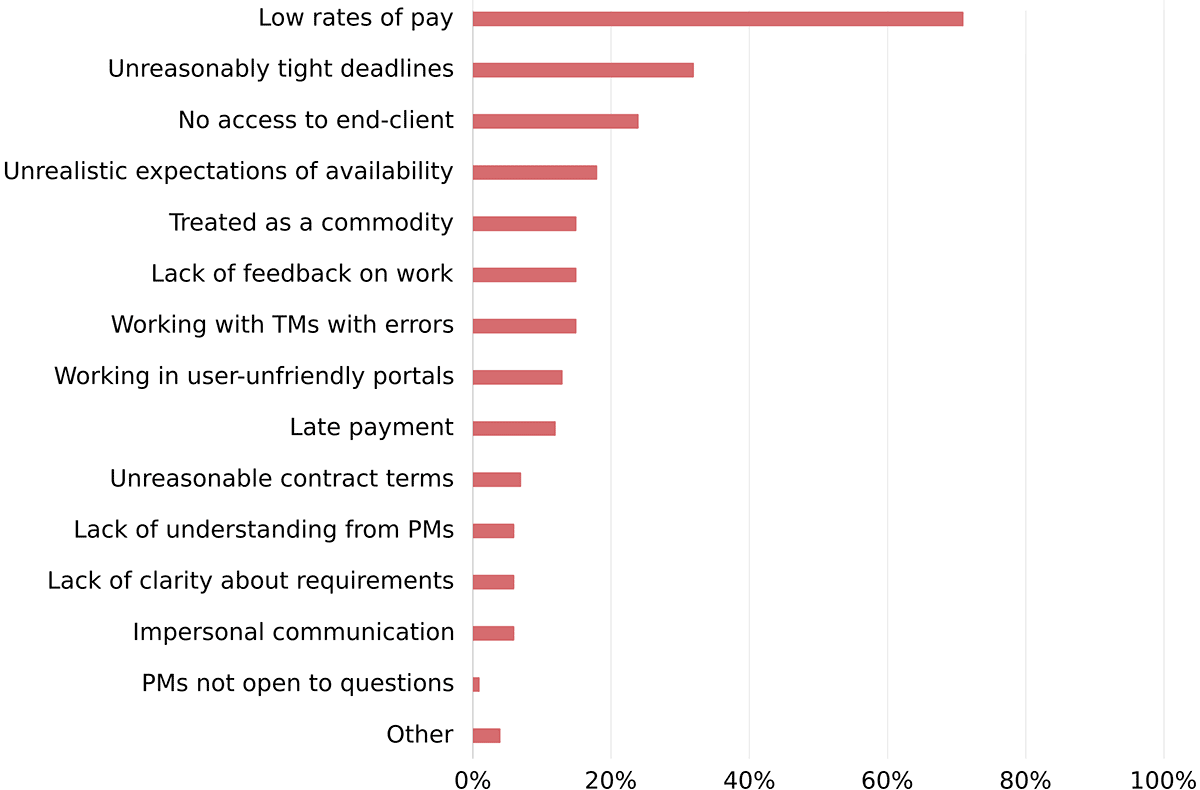
As in 2020, by far the most commonly experienced challenge/difficulty of working with translation agencies was “low rates of pay”, with 71% of respondents who work with translation agencies saying that this is a problem or challenge for them, an increase from 59% in 2020. All other listed factors were cited by less than a third of these respondents, as in 2020. “Unreasonably tight deadlines” was mentioned as being a challenge by 32% in both years of the survey, with “No direct access to end-client for clarifications” mentioned by 24% of respondents in 2023 and 25% in 2020.
In the current year’s survey, 18% of respondents who work with translation agencies mentioned “Being treated as a commodity” and 15% cited “Lack of feedback on my work” as main difficulties of working with translation agencies, while 15% highlighted the challenge of “Having to work with translation memories that contain errors”. All other possible challenges/difficulties listed were mentioned by less than 15% of respondents.
77% of translators work with direct clients
The 2023 survey results revealed that 77% of respondents work with direct clients, compared with 81% of respondents to the 2020 survey.
Higher rates of pay and ease of communication are the main benefits of working with direct clients
Those who work with direct clients were asked to cite up to three main benefits of doing so and the percentages citing each factor are shown in Figure 41. The distribution of responses was almost identical to that for the corresponding question in the 2020 survey.
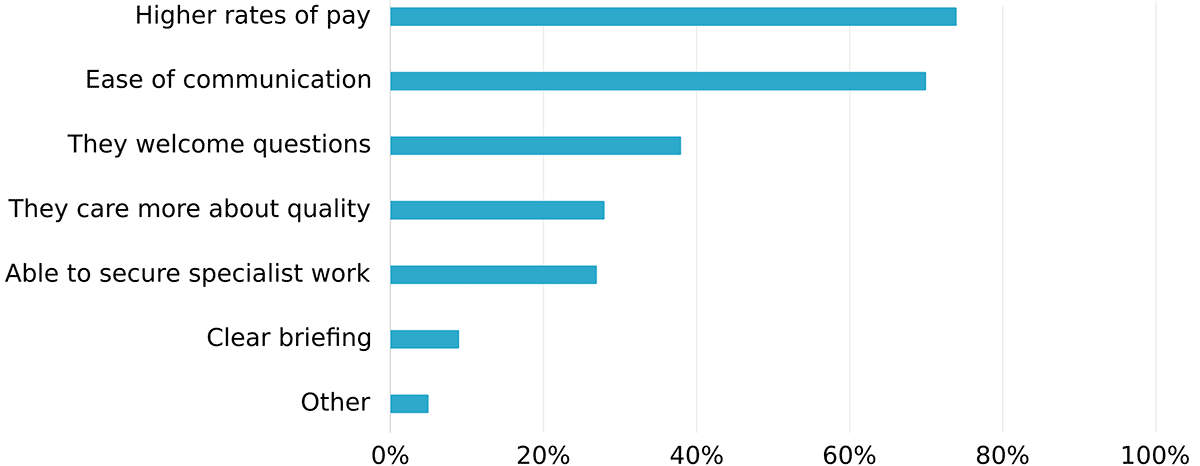
As in 2020, the most commonly perceived benefits of working with direct clients are “Higher rates of pay”, cited as a benefit by 74% of all those who work with direct clients, and “Ease of direct communication”, cited by 70%. These were the only two factors mentioned as main benefits by large percentages of respondents.
Lower percentages indicated that “They welcome questions and feedback” (38%); “They care more about quality” (28%), “Ability to secure projects in my specialist field” (27%), and “Clear briefing” (9%) are main benefits of working with direct clients.
26% of translators who work with direct clients do not experience any challenges
Respondents who work with direct clients were also asked to indicate up to three challenges or difficulties they experience when doing so, or to indicate if they do not experience any challenges or difficulties.
In contrast with the 6% of the respondents who reported experiencing no challenges or difficulties when using translation agencies, around a quarter (26%) of those working with direct clients said that they do not experience any challenges or difficulties when doing so, indicating that, on the whole, this sample of translators find working with direct clients easier than working with translation agencies.
As in 2020, the distribution of respondents experiencing various types of challenges or difficulties when working with direct clients was also found to be quite different from those experienced when working with translation agencies. The findings relating to direct clients are shown in Figure 42.
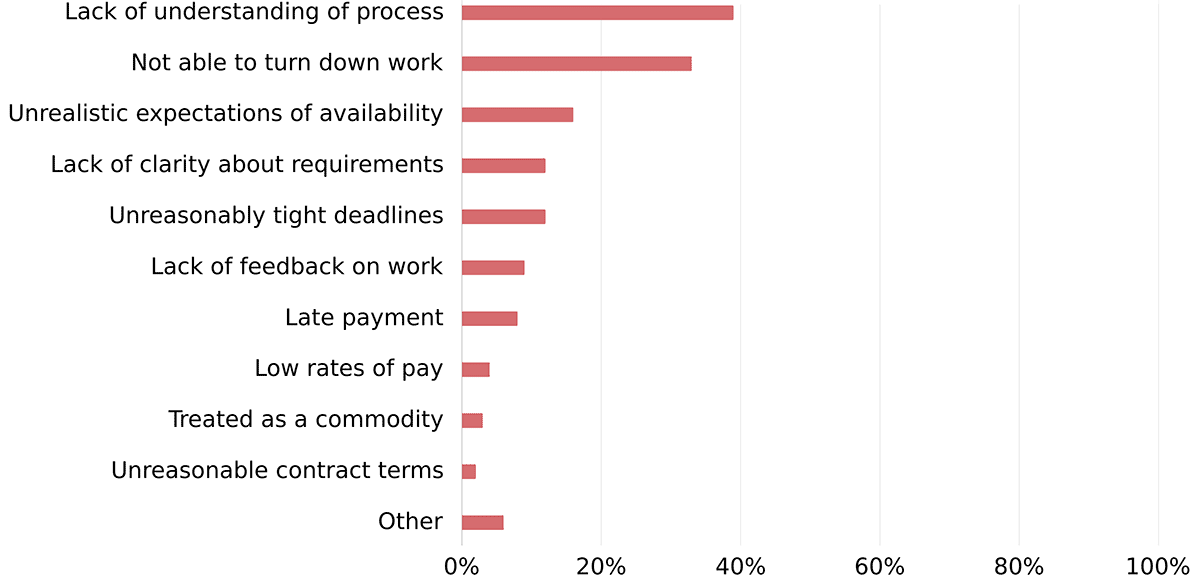
In general, lower percentages of respondents indicated that they experience each of the listed difficulties/challenges when working with direct clients compared with those working with translation agencies.
Clients’ lack of understanding of the translation process is the main challenge when working with direct clients
The top three most commonly experienced difficulty/challenges were the same as in 2020: “Lack of client understanding of the translation process”, cited by 39% of respondents in 2023 compared with 37% in 2020, and “Difficulty in turning down work/saying ‘no’”, experienced by 33% of those working with direct clients in 2023 as against 31% in 2020. “Unrealistic expectations of my availability” was seen as a main challenge/difficulty of working with direct clients by 16% of respondents in 2023. The other factors listed were mentioned as main challenges/difficulties of working with direct clients by 12% or less of all respondents who do so.
More translation agencies than direct clients find translators using ProZ, LinkedIn and professional associations members’ directories, while referrals (from other clients or colleagues) bring more direct clients
We were also interested in finding out how the various types of clients (translation agencies, direct clients and private individuals) find out about the freelancers and their services. Various channels and ways of obtaining information were listed and the respondents were asked to tick which are generally used by different categories of clients, or to specify “other” ways in which information about them is obtained. The distribution of responses is shown in Figure 43.
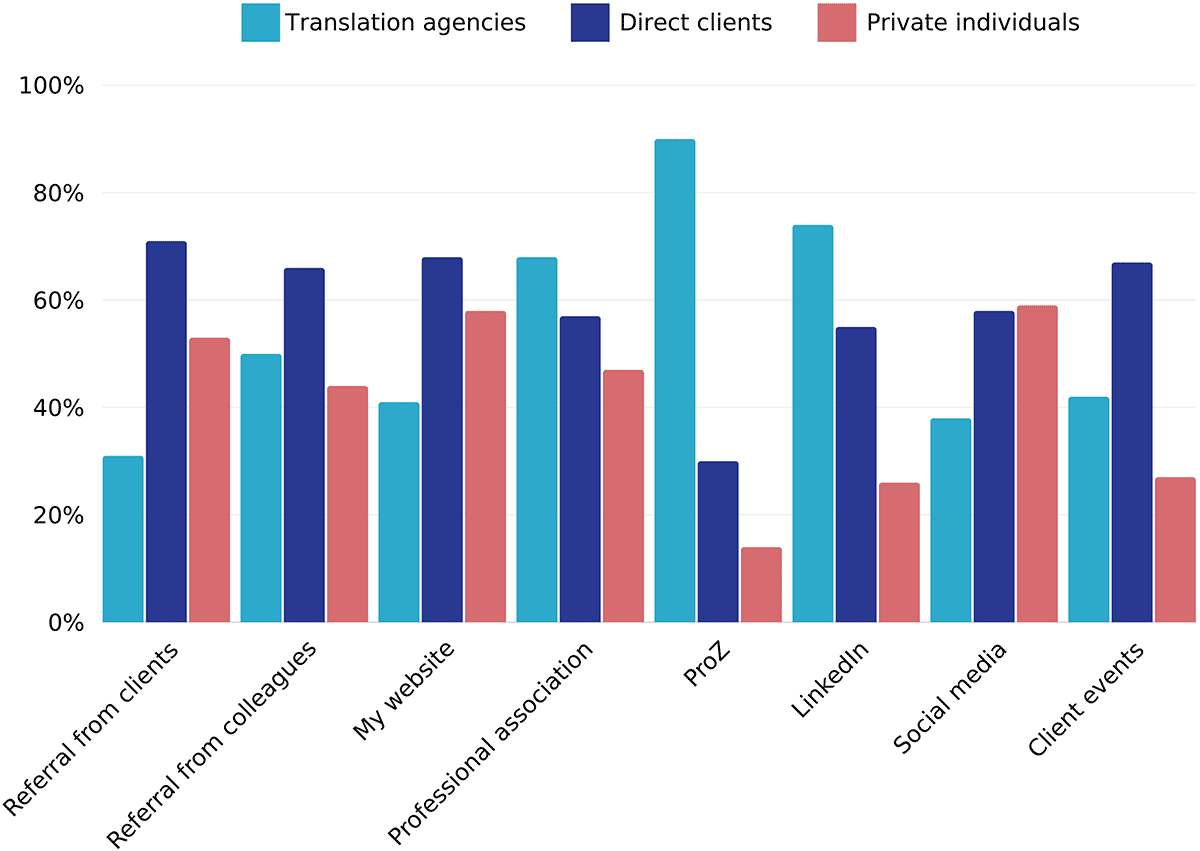
This shows that a wide range of methods are believed to be used by all types of clients to obtain information about the freelance translators and their services. For translation agencies, ProZ.com is the most commonly used source of information, with 90% of respondents saying that their translation agency clients use this site. However, only 30% said that ProZ.com is used by direct clients and only 14% reported that the site is used by private individual clients. Translation agencies are also particularly likely to use LinkedIn, according to 74% of respondents, or a professional association members’ directory, according to 68%.
Relatively high numbers of respondents indicated that their direct clients generally find out about them and their services through word of mouth from other clients (71%), word of mouth from other translators (66%), their website (68%), and attending client events (67%). Finally, the respondents reported that private individual clients are most likely to find out about them via their website (58%) or social media (59%).
152 respondents provided “other” responses when asked how their clients find out about them. Many were not applicable responses but some included, for example, the freelancer contacting the client, own advertising, online job sites like Upwork, or only working through translation agencies.
A website conveys a professional image according to 75% of translators who have one
The findings also revealed that 43% (n=737) of the 1,734 respondents who provided this information have their own website. These respondents were asked to indicate up to three main perceived benefits of having a website, and the percentages citing each listed factor as a benefit are shown in Figure 44. The ranking of benefits and the percentages of respondents citing each are almost identical to the corresponding findings from the 2023 survey.

The most frequently mentioned benefit of having a website is “Conveys a professional image”, mentioned by 75% of respondents who have a website, followed by “Ability to display information about my services” (66%). Around half (51%) of those respondents who have a website perceive that making it “Easier for potential clients to find out about me” is one of the main benefits, and 43% expressed the view that “Building credibility/trust” is a main benefit. Only 19% of these respondents felt that the “Ability to display an online portfolio/examples of work” is a main benefit of having a website.
A third of translators who do not have a website are intending to have one
When we asked the remaining respondents to indicate the main reason for not having a website, the responses revealed a wide spread of reasons, as shown in Figure 45.
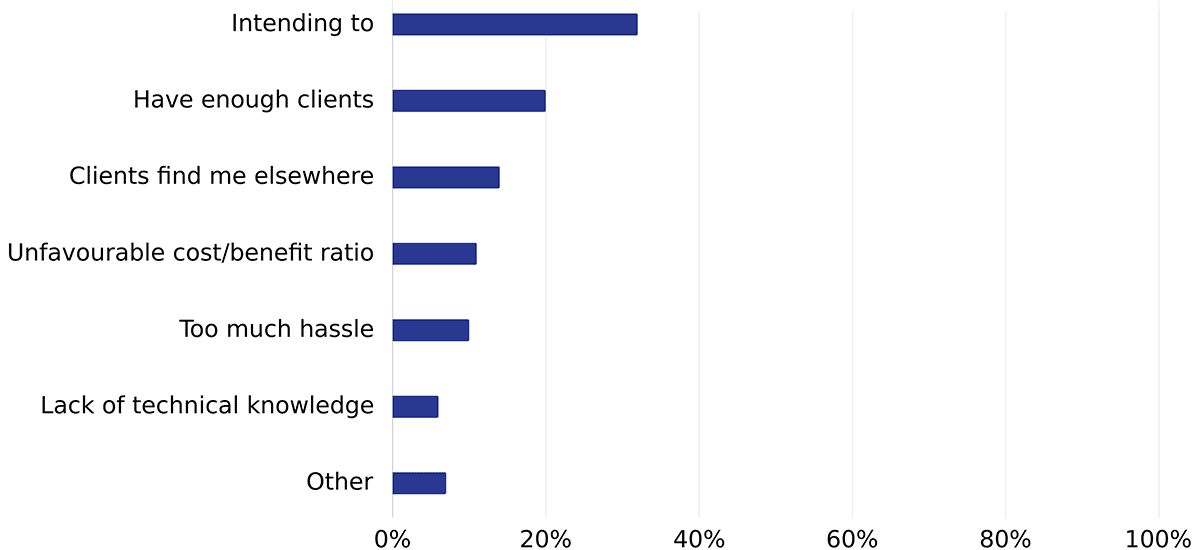
Around a third of these respondents reported that they were intending to establish a website but had just not yet got round to doing so (this factor was not included in the 2020 survey). 20% indicated that they already have enough clients so perceive no need for a website, and a further 14% said that their clients can find them through other means. Ten percent said that it is too much hassle to set up a website and 11% expressed the view that it is not cost-effective for them to do so. Just 6% indicated that they have no website because of a lack of technical knowledge of how to establish one, compared with 17% giving this response in 2020.
Only a third of respondents carry professional indemnity insurance
We also asked respondents whether they have professional indemnity insurance (PII), professional liability insurance (PLI), errors & omissions (E&O) or a similar form of cover. Only 32% of the 1,734 respondents who answered this question said that they do have some form of professional indemnity insurance or similar, but this was an increase on the 24% of respondents in the 2020 survey who reported having such cover.
Clients – frustrations
We asked an optional question “What is the one question that you frequently receive from clients, if any, that annoys or frustrates you?” for respondents to answer in their own words. 710 took the opportunity to do so. Of these, 60 (8%) said that there are no particular questions from clients that annoy or frustrate them.
The other responses were organised into themes and sub-themes and are summarised below with example verbatim responses:
More than a third of translators are frustrated by questions or comments relating to rates/discounts
The most common type of response, mentioned by 255 respondents or 36% of all those answering this question, related to client requests regarding rates, discounts and free work. The responses fell broadly into the following themes:
Requests to waive minimum fees or offer a discount
“Our budget is tight, could you waive your minimum fee this once?”
“Would you be willing to reduce your rates by X (usually more than 50%) to meet the rate we usually pay translators?”
“Would you accept to lower your rates as we offer a large project with high volume?”
“Asking to lower my rates for specific projects or end-clients, or threatening to send less work if I don’t”
“After I finish a task, they ask: Can we get a discount?”
“Major agencies are always trying to haggle even if you repeatedly tell them your rates are not up for negotiation”
“To offer a discount due to MT used in their platform even if it does not add value to my language combination and/or the specific project”
“Can you do the work on expedited basis but not charge us expedited rates?”
Requests for free work
“When a job is closed and they ask for free editing”
“Will you do this project for free?”
“To do additional things for the project free of charge (extra segments and checks)”
“Asking about a free test sample before talking about rates. I hate when I give my best to deliver the best quality and later read that the client is happy but can only pay peanuts.”
Trying to reduce costs by asking translator to review/edit work done by cheaper providers or machine translation
“Can you check this translation in your specialist professional field? We’ve had done by a (cheaper) colleague.”
“Could you please proofread a text I translated into English myself.”
“Our employee Mr/Ms X lived in the US for a long time and can speak English like a native. … Could you just glance at the text they wrote in English and check it?”
“Can you just edit this document I put in Google translate?”
Questioning the cost of the service
“That much? Why? My “X” knows English and HE/SHE says it easy…”
“It’s not too complicated, isn’t it? Why does it cost so much?”
“Your rates are too high for your language combination”
“Why do you charge so much, I can get it for free through Google Translate”
Almost a quarter of translators find unrealistic or unreasonable expectations from clients frustrating
A total of 166 respondents or 23% of those answering this request mentioned various ways in which their clients have unrealistic or unreasonable expectations. Specifically, these included:
Unreasonable deadlines/short timescales for work, or pressure to deliver quickly
“After agreeing to a deadline, being asked if I can deliver the translation sooner.”
“Informing me that they want me to work on a project and I have to deliver it within an hour or so.”
“This is short, could you do it for free, and within the next hour?”
“Could you have this 10,000-word project for tomorrow? It’s urgent!”
“Can you submit it within the day? But the payment will be on the next month.”
“Unrealistic/tight deadlines”
“Sudden changes to schedule (bringing previously agreed deadlines forward)”
“Can you take on another 2k words by tomorrow even though we literally just agreed a large project that will definitely take all your time for the next two days?”
Expected to work evenings/weekends
“Being asked to work weekends/ evenings (i.e. if I didn’t, I’d struggle to meet the deadline or potentially miss out on other work that might come the following day/week if I left the job until then) after being quiet all day/ week.”
“”Can you do it by Monday?” (on a Friday)
“Particularly common are requests for quotes and orders after 6pm on Fridays, with projects due for delivery on Monday morning.”
“Asking me to work outside of normal working hours or at weekends without any extra remuneration”
Pressure to take on work
“Why can’t you squeeze this in, it’s only small?”
“it’s only x pages, it won’t take you that long”
“Asking me if I can help while I have already told them I am not available”
“When I’m busy and say I’m busy and the person says can you fit it in, it’s very short, and they don’t take no for an answer.”
“When they insist after I turned down the project – with the same conditions they initially offered.”
Asking for services or languages that are not offered
“Enquiries for languages I do not offer or for the wrong translation direction, despite having “seen my information on xxx directory”
Lack of understanding of professional translation
A total of 112 respondents, or 16% of those answering this question, indicated that their biggest frustration relates to a lack of understanding on the part of clients about the skills and time required for professional translation, with many failing to understand how this differs from machine translation.
For example, comments relating to machine translation included:
“Isn’t Google translation faster?
“Why should we pay a human to translate this document when we could just use Google Translate?”
“”Why is your translation different from what Google Translate says?”
“Being offered “proof-reading” jobs that are in fact MTPE ones and require much more work than just dotting the Is and crossing the Ts”
“A surprising number of direct clients assume that translators simply use Google Translate and correct a couple of errors before delivering to the client and ask how THAT can possibly take so long and cost so much.”
“Whether it is possible to save money by sending me machine-translated or self-translated texts for editing rather than translation – correcting these is frequently more difficult and time-consuming (and thus expensive) than translating it myself”
“I am annoyed when clients ask me if I can do MTPE jobs for ridiculous rates (like 0,01 € per source word)”
“When they ask me to edit something they have used machine translation for to try and cut corners. Machine translation still requires knowledge of source and target language”
While other respondents cited the following types of questions from clients demonstrating a lack of understanding of professional translation:
“Whether I can translate into one of my source languages.”
“It is easy, do you need to be paid?”
“I have a friend who does some proofreading. Can I use her?”
“It’s just a re-typing job, isn’t it?”
“Clients who think that translation is a mechanical process and don’t understand that even the “easiest” jobs require translator engagement (time, skill, experience/expertise).”
“They think a short text is easy and quick to turnaround when it may involve a lot of background research for contextual information or terminology previously used and needed for consistency.”
Lack of respect for professional expertise and credentials
46 respondents (6%) indicated that they are most annoyed by clients who show a lack of respect for their expertise and credentials. For example:
Challenging or questioning their work:
“Why did you use this word and not that word? (e.g. they think they are flagging up inconsistencies when they find different spellings such as programme and program”
“When they use machine translation to check my translation and ask me to change it based on MT”
“Questions about English grammar, word usage, etc… it makes me feel like I always need to defend my choices, and that they have the expectation that I’m also there to teach them English”
“When non-native clients question translation choices when they are far from proficient in the target language”
“When they run an automatic QA on my translation (they don’t speak the language) and then ask me to check the errors flagged by the QA software (false positives)”
Querying credentials or requiring additional evidence:
“Asking to provide a CV and take tests at the same time.”
“Usually, some agencies request official documents as a certificate of residence even before taking a test or receiving my first project.”
“I don’t think someone approaching a solicitor via the Law Society directory would expect that solicitor to send them his/her CV or submit to a test piece. I can’t think of any other professionals who are so constantly asked to undergo additional tests when they already have recognised qualifications.”
Inadequate client support, information or feedback
These types of responses were given by 36 respondents or 5% of all those answering the question. For example:
“How much would it cost (e.g. on the phone, without possibility for me to inspect the document”
“Giving a sample translation and never getting a feedback.”
“Lack of feedback/acknowledgment of receipt of work done or asking for price then never responding”
“When they reject my availability to cooperate without explaining why”
“How much will it cost to translate this website?”
“Translation agencies / project managers failing to get clear answers (or *any* answers) from their end clients in response to the questions I submit, and having to deliver a translation that I know is sub-standard or incomplete.”
“When they do not meet the schedule we agreed on.”
Current affairs
We took the opportunity in this survey to explore the impact of the Russia-Ukraine war on our sample. Respondents were asked, “Has your job as a freelance translator been affected in any way by the Russia-Ukraine war?” The distribution of findings is shown in Figure 46 and reveals that only 13% (n=229) feel they have been affected by the conflict. Around two thirds (63%) of all respondents who answered this question said they have not been affected, while 24% were unsure.
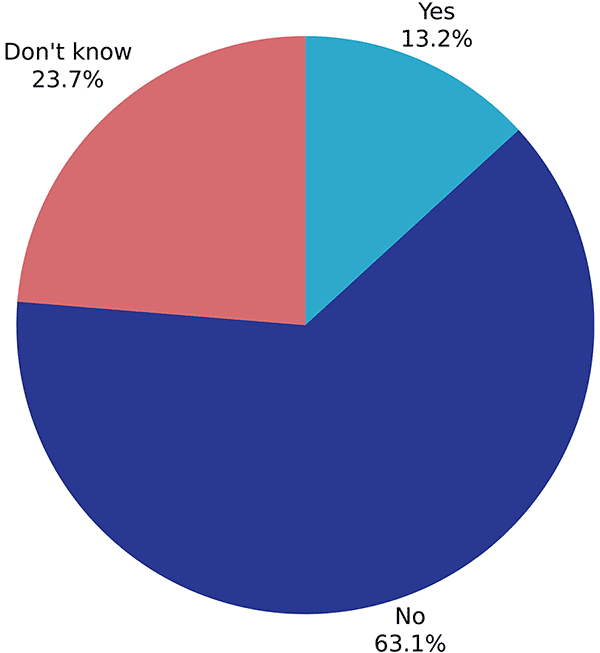
Those respondents who said their job as a freelance translator has been affected by the Russia/Ukraine war were asked to briefly describe the ways in which they had been affected. 205 respondents took the opportunity to do so, and their responses fell broadly into the following categories:
Lost work, reduced market demand (n=104, 51%)
“I was working on a Russian subtitling project when the war broke out. The project got frozen/cancelled and I haven’t had any work with Russian since.”
“Lost a big contract due to suspension.”
“Less work due to clients working with translators with lower rates due to the higher cost of living”
“I had to lose my Russian clients. I cannot withdraw Russian rubles (which I earned working hard) from my Ukrainian bank account. I had to move to another country and find new clients remotely.”
“I used to have a Ukranian client. Haven’t heard from her ever since”
“Because of the cessation/suspension of clinical trials in both Ukraine and Russia, the number of projects in my linguistic pairs has decreased.”
“I had a developing relationship with a children’s literature foreign rights agent in Russia and was hoping to do more work with her. That has sadly been put on hold.”
“I was forced to flee Ukraine and lost contact with my usual clients”
“I live in Russia. Workload from my main direct client (Booking.com) decreased dramatically. I can’t find any new clients because they either don’t want to collaborate with translators located in Russia or are unable to make bank transfers to Russia due to various restrictions”
More work, increased market demand (n=27,13%)
“As I work with international organisations dealing with international law matters, this means more work opportunities/new clients and more translation projects.”
“Sadly in a positive way, because I do political translations and translations for think tanks. I often translate papers on Ukraine. My first subtitling job also came from a project related to Ukraine.”
“More translation from Russian and report-writing for World Health Organization”
“I returned to translation work exclusively as a direct result of the war. I specialise in nonfiction (current affairs, history, politics, human rights) and want to translate independent voices and aid understanding of the war.”
“In terms of volume of jobs, it has increased due to high demand in humanitarian translation.”
“All disruptive events (financial crisis, Covid, etc.) generate work for translators (annual reports, economic articles, etc.)”
“I am a highly accredited Ukrainian interpreter. Since the war started, I worked pretty much non-stop with hardly any days off. Wake me up at night, and I will be ready to interpret high level formal meetings or speeches of top people in Ukraine.”
Some of these respondents reported both less and more work as a result of the War, for example a decline initially and then an increase, or a shift in demand for different language translations.
“At the beginning no work at all, after – work increased”
“There was a sharp drop in work in March 2022, but then the volume of work recovered. I’m not sure if I’m receiving more work now from Western agencies because I’m *not* based in Russia. I worry about my translator colleagues in Russia.”
“Fewer jobs with Russian, more jobs with Ukrainian (both are in my language combinations)”
“As I work with both languages involved, it changed the structure of my clients and types of orders, without affecting the overall workflow”
Inflation/cost of living impacts (n=27, 13%)
“Inflation in my country due to high price of US dollar”
“Inflation/scarcity of goods – Companies are less willing to spend on translation”
“The war has indirectly affected my job through inflation, which has reduced clients’ purchase power and made them more reluctant to accept rates. Therefore, lately, they tend to care more about price than quality.”
“The war caused worldwide economic depression, which drastically lowered my overall earnings”
“It has led to inflation and lay-offs in several of the industries in which I have clients.”
“I’ve had to raise my rates considerably because my energy bill has tripled. I’ve had clients pre-emptively refuse to agree to higher rates for (presumably) similar reasons.”
Refusing work on ethical grounds (n=16, 8%)
“In the past I have done a lot of work for WIPO the UN patents agency through one agency in UK. As a result of the war, the agency suspended its work with WIPO and I was offered work directly since the UN was continuing to work with Russia. I refused on ethical grounds and this has had a significant and direct negative impact on the volume of translation work I now receive.”
“The main part of my freelance job before was translations from Russian to Ukrainian and from Ukrainian to Russian. Since the day when war began I refused them and I don’t have any intention to change this approach.”
“Had to turn down a large project with a Russian client because I felt it was wrong to work with them.”
“Many of my Russian clients are against the war, but the fact remains that they are based in Russia, and I’m not sure I want to be making money for companies who pay taxes to the warmongering Russian government … I think it’s likely I will be leaving the translation industry in the coming year, for various reasons, but partly because I just don’t want to be involved with Russia anymore.”
“I have lost half of my clients in Ukraine and can no longer accept work from my Russian clients because I believe it’s not ethical to work with them anymore”
Payment difficulties (n=15, 7%)
“As I work with Russian language, I no longer work with clients in Russia, which is the main market, because it’s hard to receive payment.”
“I cannot withdraw Russian rubles (which I earned working hard) from my Ukrainian bank account. I had to move to another country and find new clients remotely.”
“I am experiencing difficulties in obtaining payment from clients due to sanctions against Russian banks”
“I lost my job because it is impossible to send money to authors”
“Several of my favourite clients simply stopped making their products available outside of Russia because of financial difficulties, which meant no more work for me.”
“I can’t work with existing clients who only transfer payments via PayPal, Payoneer, etc., that have become unavailable in Russia.”
Disruption to daily life In Ukraine (n=9, 4%)
“Limited capacity due to electric power switch-offs here in Ukraine after Russian missile attacks.”
“Since I am from Ukraine, it has affected both my private and professional life in every way. All my translations are now related to the war to some extent. I have to juggle my work and blackouts/missile attacks to meet the deadlines.”
“I was forced to become a freelance translator rather than a full-time employee as my translation agency closed the physical office in Ukraine. Also, my productivity now is much lower due to emotional reasons. Above that, there were several periods with no or a lack of electricity and internet in my region, so I couldn’t work.”
“I live in Ukraine. So have to find a way to work amid air raid alerts, blackouts, drone and missile attacks, etc.”
Volunteering/Pro bono work (n=7, 3%)
“I prepared free-of-charge translations for Ukrainian refugees.”
“Done some urgent work for a Ukrainian colleague, some pro bono”
“I have not lost (or gained!) any money from the war, but have dedicated work hours to support Ukrainian friends.”
We also asked whether respondents expect that their job as a freelance translator is likely to be affected in any way by the Russia-Ukraine war and only 5% (n=70) of the 1,510 respondents answering this question indicated that they expect to be affected. Fifty-nine percent said that they don’t expect to be affected by the war, and 36% that they don’t know (Figure 47).
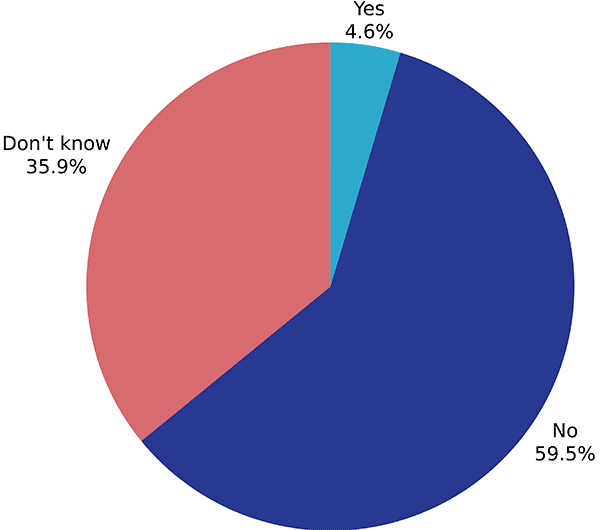
Those respondents who said that they expect their job as a freelance translator to be affected by the Russia/Ukraine war in future were asked to briefly describe the ways in which they expect to be affected. Forty-six respondents took the opportunity to do so, and their responses fell broadly into the following categories:
Reduced demand due to inflation and budgetary pressures (n=21, 46%)
“Global impact of the war leading to major inflation and increase in cost of living, leading to businesses cutting costs and therefore not commissioning as much translation.”
“Downturn in economies and therefore greater cost pressure/less work coming through.”
“The war has sent prices through the roof, causing inflation, which means that companies have less money to invest and spend, and cut down on what they believe to be unnecessary services (including translation: machines can do it well enough).”
“I work a lot in the technical/industrial field and I believe that many clients will cut their translation budgets and redirect them to higher costs of everything (energy, raw materials etc.)”
Downward pressure on rates due to inflation and budgetary pressures (n=11, 24%)
“Rates are decreasing as companies seek to cut on costs”
“Possible lower rates or rates remaining same due to financial uncertainty and the financial situation globally.”
Reduced demand for specific language combinations (n=10, 22%)
“Because I have the Russian language in my combination and I can’t reach out to Russian agencies like before or don’t get much work”
“Less requests for my languages pairs since right now the focus is the war and the need for Russian and Ukrainian translators.”
“Pull NGO work away from my language combinations”
Increased demand (n=3, 6.5%)
“More translations from Russian as people move to the UK”
“As in any big conflict in history, the areas that will experience a huge development are technology, manufacturing, telecommunications, logistics, trading, etc. Since I am a Technical Translator, I normally get to translate many of those topics, so I’ll probably have more work, or at least more steady work.”
Other (n=4, 9%), e.g.:
“The possible attack on telecommunication infrastructure like the cables linking US with Europe, as I work with US clients and this is how I receive work and get paid.”
“I work mainly in the international development context. I fear the stalling of international development cooperation and the allocation of funds to other domains like security and defence.”
Effects of the COVID-19 pandemic
The survey fieldwork period in early 2023 coincided with the final stages of the COVID-19 pandemic. This gave us the opportunity to ask whether respondents’ freelance translation jobs were being affected by the pandemic, and to compare the findings with those of the 2020 survey, conducted in the early stages of the pandemic when COVID-19 was rapidly spreading.
In 2023, just 338 respondents or 20% of the 1,687 who answered this question said that their jobs were currently affected by the COVID-19 pandemic, compared with 61.5% of respondents in 2020.
The 338 respondents who reported in the 2023 survey that their job as a freelancer translator was currently being affected by the pandemic were invited to describe these effects. A total of 338 respondents took the opportunity to do so, and their answers were analysed and categorised as follows:
Reduced demand (n=203, 60%)
Of those indicating that their job as a freelancer translator was currently (early 2023) being affected by the COVID-19 pandemic, the majority (60%) said that demand for translation services or their field of work had been reduced as a result of the pandemic.
“Business went into saving mode and translation is not generally a priority.”
“Tourism/travel related projects has decreased quite a lot”
“During Covid-19 my income was decreased by 70%. I was in the lowest of my life.”
“As I do a lot of work relating to clinical trials, the availability of work decreased when many trials were suspended during the pandemic.”
“My workload dropped and hasn’t recovered. Also, fewer clinical trials were started during this time”
“Since the pandemic started, my workload has fallen off a cliff and has never recovered – also I think Brexit and machine translation are contributing to this decline.”
“The aftermath of the COVID-19 pandemic has had consequences that have heavily affected the volume of work I now receive.”
“Texts are translated and go directly to proof, no Post-editing, QM and rates are lower than in 2022. Very few jobs since the start of 2023.”
It should be noted that some of these answers referred to reduced demand during the pandemic generally rather than the current context, while others referred to the interacting influence of other factors such as the global economic recession, Brexit and the increasing use of machine translation. As a result, these responses relate largely to the impact of the pandemic on the respondents generally, and a direct comparison with the 2020 findings is not very meaningful. However, a few respondents specified that work had initially increased during the pandemic but had since declined:
“I had much more work during the lock-down. It’s only now that I am feeling a drastic downturn in project offers.”
“As a business translator, I had plenty of work during the pandemic (customers explaining their precautions, setting rules etc.) but after the pandemic eased off turnover was very low for several months.”
Increased demand (n=52, 15%)
In contrast, some respondents reported that their work had increased due to the pandemic, due for example to increased demand in fields relating specifically to the pandemic or due to a release of pent-up demand more recently.
“Work has been slow for a while, then lots of work about the guidelines and vaccinations”
“I work with several clients in the international health sector (fight against epidemics and access to essential medicines mostly), so this means an increased workload.”
“Higher demand for multinational internal content as companies communicate with their employees remotely”
“COVID-19 meant that there was reduced immigration to Canada for a year and subsequently the Canadian government has increased its immigration goals, so there is more immigrants and paperwork.”
Shift in types of work or working arrangements (n=31, 9%)
“Lower volumes from some clients but higher volume from others”
“My agency work before was more fashion-related and frivolous, now it’s much duller”
“I noticed an increase in certain types of projects (e-commerce, online businesses), while others (tourism) severely reduced.”
“Fewer meetings initially, no work onsite at UN Office in Geneva; now mainly hybrid meetings, serviced by working from home.”
“Less on-site interpretation but more video /online interpretation”
“Lost contacts due to Covid-19 and the lockdown but it was compensated by Zoom interpretation”
Lower rates or increased competition (n=16, 5%)
“Forced to settle for lower wages.”
“Many people who were laid-off or lost their employment entered the field without qualifications and compete with very low rates.”
“Since many people have been negatively affected financially by the pandemic, I find that many of my clients aren’t able to pay my usual rates, especially when it comes to academics.”
“Attempt to drive prices down all the time.”
Demand reverting to normal post-pandemic (n=15, 4%)
“As I work with Brazilians that left the Country, with the pandemic many of them were prevented to move. After the covid situation has settled, things are going back to normal”
“My level of work dropped significantly because clinical trials were cancelled/suspended due to Covid. It has picked up again and has more or less returned to normal now though.”
“During the pandemic there was no audio-visual production, but I notice a lot of workload increase when they returned”
Miscellaneous
Finally, a range of miscellaneous comments were received about the impact of COVID-19 on the respondents’ freelance translation services. For example, a few highlighted the increased use of machine translation, some mentioned that they had caught COVID or were in a high-risk group and that this had affected their ability to work or take on in-person assignments, while several said they had become a freelance translator as a result of the pandemic.
“Many clients have resorted to machine translation and many of them have resorted to not outsource translations at all.”
“Due to illness having to retrain and spend more time at home”
“I hesitate to visit conferences, meetings with colleagues, coworking spaces etc because of the risk of infection”
“Chose to become freelance translator due in part to in-house job’s poor handling of pandemic circumstances.”
“It’s the reason I started my translation business (after being made redundant because of COVID-19 – related difficulties the organisation I worked for had.”
Improving life as a freelance translator
Finally, respondents were asked “If you could change one thing not currently under your control, that would make your life as a freelance translator better, what would that be?” Overall, 882 respondents took the opportunity to answer this question. Some key themes emerged in their responses, as follows:
Improved or regulated/standardised rates of pay
The majority of responses to this question related to pay rates, with respondents either suggesting there should be higher rates in general for freelance work, or that these should be standardised or regulated. Some commented on the issue of some freelancers accepting very low pay, which is driving rates down generally in the industry, while others noted that pay rates vary considerably by country.
“I would just want to be earning more. I suppose my rates are within my control but I feel as though for my income to increase enough, I would need to be on rates that would never be accepted by translation agencies.”
“Much higher rates and clients who are happy to pay them.”
“Global minimum rates for translators”
“Fixed rates without needing to negotiate rates for every individual project”
“We should be offered better rates. Some of the translators accept very low rates due to many reasons and this is driving the unequal rate scenario in our industry.”
“People working as translators at unsustainably low rates”
“Fair rates for freelance translators no matter which country they live in.”
More/regular/steady work
The second most common type of response related to having more work offers, or a more regular or predictable workflow throughout the year.
“Increase the inflow of high-paying customers”
“I would like more clients, in any field.”
Steady flow of work instead of the usual “feast and famine”!”
“Having steady work and not having to worry about financial security.”
“I’d love to have more stability, with consistent workflows all throughout the year, instead of having months with a significantly lower workload, and other months when I can’t deal with all the assignments received.”
Better understanding/improved appreciation or recognition of role
Many respondents indicated that the one thing that would make their life better would be an improved understanding, or better recognition or appreciation of the role of the freelance translator and what this involves. Some stressed a perceived need for people to understand the value of human translation compared with machine translation.
“A better general understanding of what human translation is, and therefore its value to the end-user.”
“Increased recognition of translation as skilled labour which must be compensated appropriately”
“Greater recognition of the importance of employing professional translators/interpreters rather than using solely online translation tools”
“Broader understanding of value of translation and what translators do and why machine translations shouldn’t be relied upon!”
Reduced use of MT/AI
Some respondents specifically mentioned that their lives as professional freelance translators would be most improved if MT/AI were not being used in this field.
“Change growing perception that all translation can be done by machines/AI.”
“That clients didn’t send me texts that have been already translated by an AI, only for me to edit and proofread them (which is cheaper, but also time-consuming)”
“I would quiet the MT PR machine.”
“I would have translation agencies not offer MT as a translation solution to clients. It’s a tool designed to make translators’ lives easier, not harder.”
“AI is a real threat. I am not sure how long this translation industry can survive.”
Increased regulation of the profession
“Establishing a governmental translation association to protect translators’ rights”
“Making it a regulated profession”
“The regulation of the profession so that there is a register of Translators in UK.”
“Formation of a regulatory body for registration of freelancers and companies in India which will prevent us from getting scammed.”
“Mandatory professional credentials for people who want to work as a translator (mandatory B.A. or similar)”
“More monitoring of translation agencies’ business practices by a higher authority, especially if dubious!”
“Introduce new laws and regulations that make holding professional qualifications more valuable in commanding higher rates of pay.”
Prompt payments
“Being able to trust to get paid on time without having to keep an eye on my invoicing and timely payment.”
“Immediate payment from all clients”
“I would introduce a contract clauses that protect translators/interpreters and guarantee payments, or make partial upfront payment obligatory”
Better working conditions or treatment from agencies/clients
“Transparency in business (lack of information about rates, none or manipulative feedback from companies, etc.)”
“For agencies to be keen about interpersonal relationships with their translators, rather than treating us like cogs in a machine.”
“Agencies treating vendors more as partners, share strategies, long-term needs, client requirements, defining best way to work with and requirements for MT / post-editing and fair rates for it”
Other comments received by smaller numbers of respondents related to ending the Russia/Ukraine war, reversal of Brexit by the UK, providing more social benefits or tax benefits for freelancers, and being able to achieve a better work-life balance.
Summary and conclusion
This report has presented the findings of a global survey of freelance translators, conducted in early 2023. This was a follow-up to our first global survey of freelance translators carried out in early 2020 and gave us an opportunity to compare many of the findings over time, as well as generating new insights into the working practices and experiences of a large global sample of freelance translators.
Authors: Alina Cincan, Florin Bejgu, Lynda Joeman
About this project
The survey
The Freelance Translator Survey 2023 is based on the first edition of the survey (you can read the report of the Freelance Translator Survey 2020) and took months of brainstorming, lots of drafts, and more months to finalise. We’d like to thank the Institute of Translation and Interpreting (Nicki Bone, Dr Joseph Lambert, Dr Callum Walker, Claire Ivins) for their support and contribution to the survey design and distribution among the ITI members.
We would also like to thank again the beta testers who helped shape the survey further:
Caroline Alberoni, Paul Appleyard, Sarah Bowyer, Yael Cahane-Shadmi, Hayley Carter-Smith, Catharine Cellier-Smart, Catherine Christaki, Elvira Daraban, Oleksandr Ivanov, Susie Jackson, Hannah Lawrence, Hayley Leva, Francesca Matteoda, Rose Newell, Gerard O’Donnell, Ana Carolina Ribeiro, Carmen Swanwick-Roa, Alicja Tokarska, Serli Varjabetyan, Tess Whitty, Ted Wozniak, Allison Wright, Vesna Zagar
Many thanks to all the translators associations that distributed our survey to their members to help us reach a wider audience and therefore be meaningful to more translators: Associazione Italiana Traduttori e Interpreti (AITI), Associação de Profissionais de Tradução e de Interpretação (APTRAD), International Association of Professional Translators and Interpreters (IAPTI), Mediterranean Editors and Translators (MET), Ukrainian Association of Translators and Interpreters (UATI), New Zealand Society of Translators and Interpreters (NZSTI), as well as to anyone who shared it with their colleagues.
If you want your association/organisation to get involved in the next edition, please get in touch.
The report
This report is entirely the work of Inbox Translation (with special thanks to Dr Callum Walker for his help with the rates analysis), so any mistakes are also ours (and you can flag them, as well as any other suggestions, by emailing Alina at alina@inboxtranslation.com).
We expect to update the report with new data analysis and findings sometime in 2024, so if you’d like us to look at particular aspects, please let us know.
Charity donation
Just like last time, deciding which charities to donate to was not easy. If we could, we would donate to each of those suggested. However, we chose three in the end, and we donated £100 to each of them: Disasters Emergency Committee Ukraine Appeal, Red Cross, and UNICEF, as these got the most mentions.

This work is licensed under a Creative Commons Attribution-ShareAlike 4.0 International License. In other words, you are free to share, distribute, or build on the content found on this page, but we kindly ask you to attribute the authors of this project by providing a link back to this page so that your audience can read more about our research.
